
issue of Sideburn was created under lockdown conditions thanks to these stars: John McInnis; all at BlatantMoto; Todd, Scott, Otto and Korry; Lenny Schuurmans; Cory Texter; Nichole Mees; Brandon Robinson; Chris Carr; Jeffrey Carver; Johnny & Alysha Lewis; Kim Thompson; JC Maldonado; Prankur Rana; Bill McDonnell; Bertrand at Cafe Racer Magazine; JeanFrancois Muguet; Wilfried Delestre; Raid71; Jacapo Monti; Ted Ellis; Damon York; Carl CFM; Andrea Vailetti; Dave & Kathy at Flat Trak Fotos; Scottie Deubler; Ed Subias; Jim Koch; Cheetah; Reparto Sportivo; Tom Bing; Danny Williams; Braking Point Images; Ferran Mas; Billy Parker; Ian Rispin; all at American Flat Track; the DTRA; massive thanks to all our advertisers old and new.
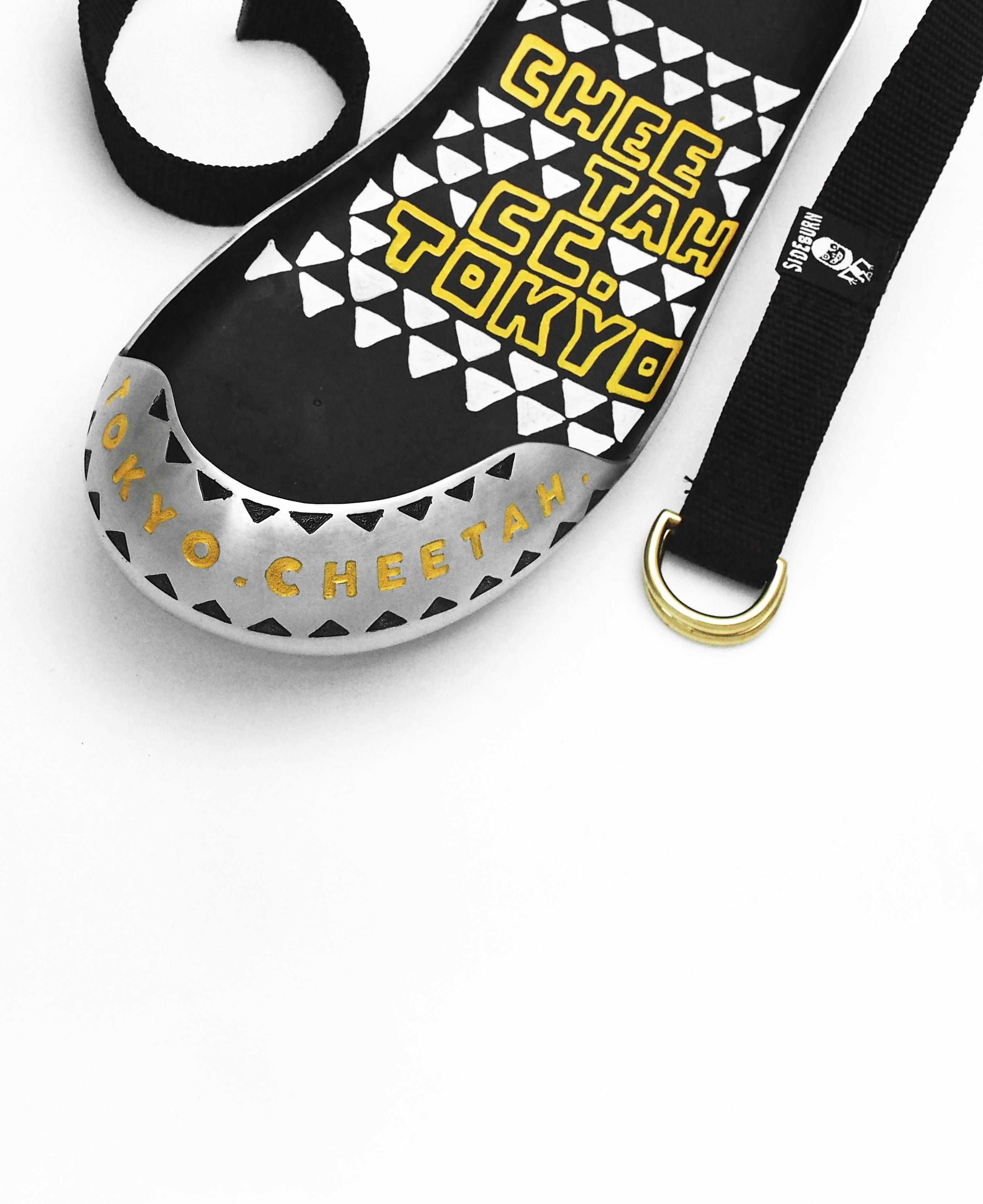
those who support the scene.
Sideburn.
Inman


Phillips
Lee
Sideburn columnist Cheetah twists everything into art. See p95 This
Support
Thank you for buying
@sideburnmag sideburnmag sideburnmagazine.com The opinions expressed in Sideburn magazine are those of the author(s) and do not necessarily reflect the opinions of the magazine’s publisher or editors. Cover: Champion MX250 & Korry Fitzpatrick by Scott Rounds Art by Lennard Schuurmans Sideburn is published four times a year by Inman Ink Ltd Editor: Gary
Deputy editor: Mick
Art editor: Kar
For advertising/commercial enquiries please email: sideburnmag@gmail.com ©2020 Sideburn magazine None of this magazine can be reproduced without publisher’s consent sideburnmag@gmail.com SIDEBURN 42 will be published in August 2020. To subscribe go to sideburn.bigcartel.com SIDEBURN IS THE OFFICIAL MAGAZINE OF AMERICAN FLAT TRACK 3

MAX28 EXPANDABLE BACKPACK Utilising Kriega’s groundbreaking Quadloc-Lite™ harness, combined with high-tech construction materials to meet the demands of the modern-day urban rider. • ROLL-TOP 100% WATERPROOF LAPTOP POCKET • FOLD-DOWN COMPARTMENT WITH ORGANISER POCKETS • MAIN SECTION EXPANDS TO CARRY A FULL-FACE HELMET 10 YEAR GUARANTEEKRIEGA.COM #RIDEKRIEGA NEW
PROPER
INTRODUCING...
SILVER
RACER
Regulars
C-Tech: Gearing
Have Fun!! Japanese
Track
NICHOLE MEES
with
BIG RED

Carver’s
GENE GENIUS
McDonnell’s
JIM KOCH
portfolio

SWAGGER
THE BARBARA
CLASSIC
MAGIC NUMBERS
number
FILTHY RICH
89 FROM BARCELONA TO SCUNTHORPE
Danny’s Astro journey
Schuurman’s Backflash
Project Bike

Racewear
Sideburn
Death Spray Custom
Trophy Queen
6
The metamorphosis of a Champion Yamaha MX250 18
Interview
the racer formerly know as Cheza 24
Jeffrey
mythical monoshock Wood Rotax 33
Bill
fabulous family scrapbook 42
New in AFT. They’re Indian, but not Indian... oh, you’ll see 49
The
of Seattle-based petrol, pedal and pen-pusher 56
Italian stylist Jacopo Monti 60
FRITCHIE
Celebrating 99 years 68
DREAM
Road race movie assessed 75
Historic
plates and the stories behind them 81
Outrageously expensive hooligan racer
Novice
20
95
Flat
97
98
100
103
merchandise 104
106
Illustration: Andrea Vailetti

Plates are hand painted with 18 for a few reasons: Korry’s birthday, the Alice Cooper song, and photos he’d seen of racers Terry Poovey and a young Mert Lawwill, both running the same digits

Proper
Words: Todd Marella Photos: Scott Rounds
7 >
ORRY FITZPATRICK IS nothing if not a patient man, an exemplar of deferred gratification, the wayward puritan of vintage flat track, Job in a Langlitz robe. He has known for some time what he wants in his dream race bike. This meticulously crafted Champion Yamaha MX250 represents the latest version of a motorcycle that has morphed from its $350 Craigslist larva infancy into the sublime grown-up version that in its majesty floats like a butterfly and stings like a bee.
Before Dirt Quake USA in 2014, Korry admits he ‘had never even heard of flat track’. Looking at his bike, this isn’t what one might suspect about the builder. It’s stunning and harks back to the golden years of dirt track racing, which, as far as I’m concerned, are 1968 to ’80.

For the following year’s Dirt Quake USA, Korry made good on his promise to himself when he showed up at Castle Rock with his newly purchased 1980 Yamaha XS650 in the back of his ’65 GMC Fleetside and was ‘ready to race’. It was his first motorcycle, and, with little modification to the bike, and the fact that it was still fitted with lights and indicators, Inappropriate Road Bike was the class for him. Although finishing well out of the glory range, he was not last, and like many first-time flat track
Built to race indoors, Korry and the Champion Yam also stretch their legs on a friend’s garden practice track. A good friend to have
racers, Korry maintains he had the most fun of anyone at the event, and was bitten hard by the flat track bug.
He then bought a bike for tearing around in the woods, which he could also race at Salem during the winter. As it turned out, the DT400 he chose was not best suited to the speedy clay short track. Setting out to find the right bike for the track, and the 250 Vintage class he was attracted to, he locked in on the ’73 Yamaha MX250.
By the winter of 2015, Korry had purchased his third motorcycle in just over a year… all Yamahas. ‘My first bike was the XS, and I just stuck with them.’ So, I ask, why vintage and not modern? ‘That’s easy,’ he replies, ‘I just like old shit. It’s cooler.’

He is mechanically inclined, curious and unafraid to tackle anything which he has the tools to accomplish. When Korry brought the MX250 home it wouldn’t start. After removing the side cover and finding the stator immersed in water, he removed the CDI, put it in the oven on low for a spell, reconnected it... and the bike fired right up. Through his fellow Salem racers, Korry became friends with Eric Purdy, owner of Cycle Heap, Portland’s own bike breaker’s yard, where he acquired 18in wheels with Duro HF308s (Pirelli knock-offs), different shocks and a set of original Ray Carroll1 bars. Add a $50 downpipe of unknown origin from a guy in Canada, and a homemade fibreglass seat pan in an attempt to emulate the old XR750 shape, and Korry had himself a race bike. The Yamaha had progressed to its pupal form.
The beginning of the 2017/18 winter indoor racing season brought more changes. Now, 19in wheels made it more official; a Borrani laced to the stock MX250 front hub and an Akront to a Barnes quick-change rear. The rear hub, fitted with a disc, required a new brake set-up, acquired after fruitful rummaging in the bins at Cycle Heap yielded the Brembo caliper still in use today, plus a master cylinder, brake line and foot control lever. It was about this time that Korry retired the homemade seat
in favour of a white Selle Giuliari Cobra-style saddle and added an old fender.
Keep in mind, Korry was soaking up knowledge on general motorcycle maintenance, repair and tuning, while simultaneously educating himself in all aspects of vintage flat track racing. A blown engine heralded his first rebuild. He also realised a Champion frame would make his MX250 a ‘real’ race bike. His search of all of the online boards yielded a painted (not plated) frame that was not originally built for his motor, but with some fabrication help from Toothless Gary, another great person within our sphere of vintage bike nerds, he could have his framer, and it was a Champion. Add to it a Clarke Triumph-style Trackmaster tank (complete with original Camel Pro Series decal); a Champion-style seat pan and Circle F pipe, and the little pupa was well on its way to becoming the beguiling beauty it is today.
During the 2018/19 season, Korry was busy getting faster and more comfortable racing the black Champion framer. He was also busy scouring swap and shop boards, as he does religiously. He likes old shit, remember? Plus, he possesses an uncanny knack for finding bargains. This time, another Champion frame, nickel plated, with Southern California history. He had to have it.
Fast forward a few weeks and Korry is picking up his new frame. On crutches, and fitted with more titanium hardware than the Bionic Man. In what seemed an innocuous low-side, getting after it exiting turn 2, Korry broke his left fibula, and broke it bad, requiring surgery and internal metalwork.
It was nearly a year before Korry was able to ride a motorcycle again, and he used that time to get his bike done properly, much of the work carried out in the workshop of fellow 250 Vintage racer, Chris DeSanty. Korry gave himself a deadline by submitting his bike for consideration at the 2020 One Moto Show in his home town, and the ensuing invitation to show it set the date.
Appendix
1 Pacific Northwest racing legend: racer, promoter and former president of the Mount St Helens Club that promoted races at Castle Rock.
>
He would also race it in front of however many thousands would seat themselves in the Veterans Memorial Coliseum to watch the action.
By the time the show was nearing, the bike had a Champion-style tank that Korry painted in the iconic speed-block design. The chosen yellow is a 2014 AlfaRomeo 4C Spider colour, Giallo Prototipo. ‘It is a little more mellow, and I knew I wanted something different than the normal Yamaha yellow,’ Korry explains. He left the tail section all black, complemented by the sensual contours of the sublime black leather seat pad, beautifully crafted with gold stitching by Roxan at Range Needlework, also in Portland.
The frame required some new mounts and a rear cradle assembly for the motor, which Toothless Gary fabricated, creating a ‘honeymoon fit’ for the powerplant. Meanwhile, Korry busied himself designing, cutting, shaping, boring and polishing all the aluminium parts for peg and foot control mounts.
The front suspension is managed by XS650 fork legs – brake and fender mounts shaved off for aesthetics –captured in a set of Weiss Racing triples. A new set of Ikons provide spring and return under the rider’s bum.

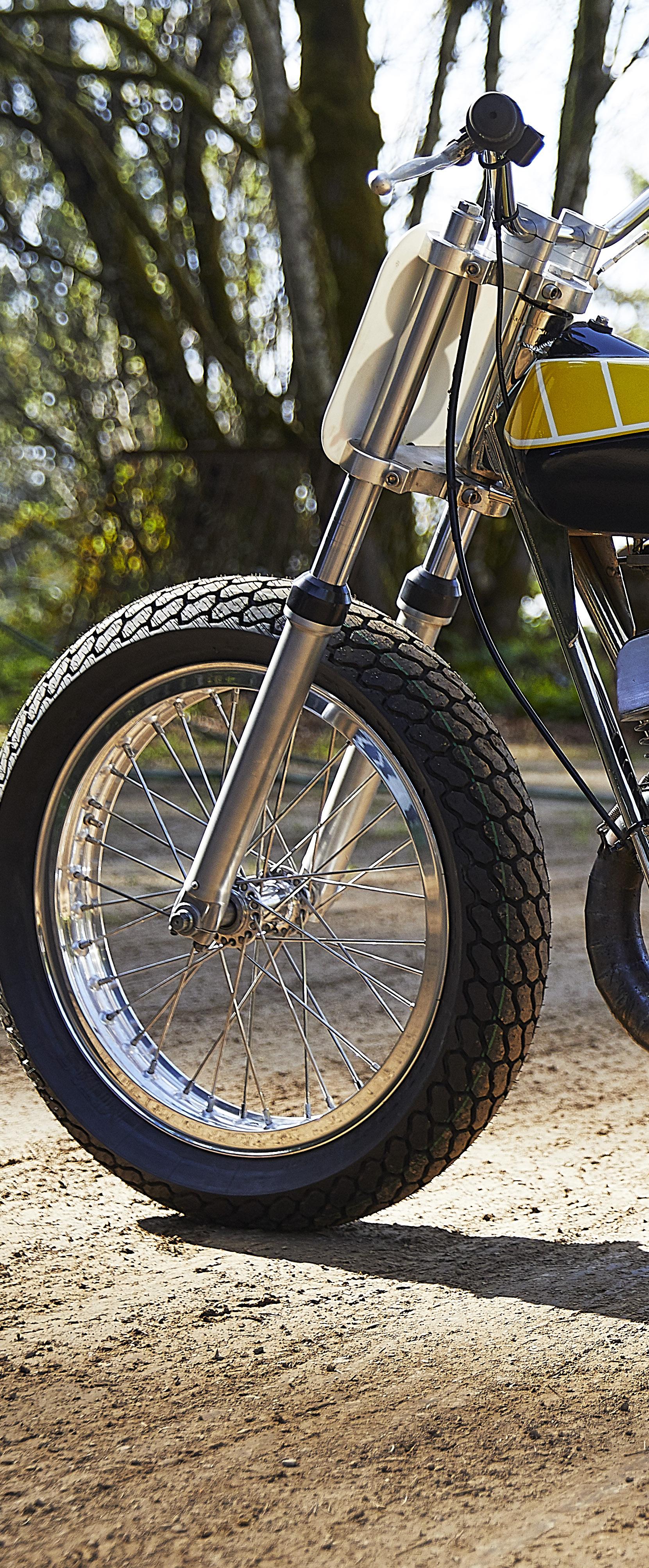
By this point, via countless hours of poring over vintage two-stroke racing boards online, old magazines, and picking the brains of anybody experienced on the subject of carburetion who would talk to him, Korry had decided that his bike needed to drink from the Lectron fountain. Hey, if Lectron flatslide aspiration was good enough for King Kenny in the Houston Astrodome, then it’s surely good enough for Flyin’ Fitz in the Salem Livestock Pavilion. As it turns out, Travis Newbold, Sideburn’s resident poet, is a modern day Lectron guru and a distributes them via his business in Fruita, Colorado, called, aptly enough, Newbold’s Motorbike Shop. Through some email conversations detailing the motor, type of racing intended, and the pipe – a bespoke expansion chamber from Retrodyne – Travis was able to set the carb up perfectly, right out of the box, letting the butterfly breathe like a dragon.
Leave it to Korry to find a guy in England who makes the some of the best racing ignition components and systems for vintage Japanese two-strokes. Rex’s Speed Shop is just the place, and their RMK-13 race electronic ignition, taking advantage of the comparatively massive rotor weight from the DT400 part it requires, provides torque where there was once just high-speed spinning. It helps the rear end hook up and tames the historically steep powerband associated with these engines.
The bike made its public debut in the pits at the 28 December 2019 Salem race. Korry sat out the actual race, preparing his bike for open practice the next day. The bike was fast and fun... until it was not. A sheared flywheel Woodruff key ended the day. However, the beast had been unleashed.

>
There were still more improvements, but the rims Korry ordered from Buchanan’s – shouldered Excels with dimples – didn’t arrive as soon as he’d hoped, so it gave him time to focus on racing (once more at Salem, and once at the little indoor track in Puyallup, WA) before the One Show in early February. He got in some quality time on the new set-up and felt faster with every lap.
The box containing rims, spokes and nipples arrived. Wheel building: how tough can it be? In his garage, armed with a borrowed wheel-truing stand, some YouTube videos and his fearless drive to learn by doing, he built his new wheels. And they are stunning. Shod with new Mitas rubber, the butterfly/killer bee reached maturity and Korry’s vision was realised. Still, as humble as ever,
he will only take so much credit, thanking the Salem Slew of Vintage 250 riders, the Top Dog and gang at Lucky Dog Speedway, and his beloved girlfriend, Hannah.
To end, my message for you is this: should you have the pleasure of seeing the bike in person, you’re fortunate. If you happen to line up in the same grid with it, be on your toes and bring your best.



©2020 H-D or its affiliates. HARLEY-DAVIDSON, HARLEY, H-D, and the Bar and Shield Logo are among the trademarks of H-D U.S.A., LLC.
Cut through the noise.
The LOW RIDER® S has performance you have to feel to believe. Learn more at H-D.com. It’s time to ride.

Who? What? When? Why? Where?
Nichole Mees
Interview: Gary Inman Illustration: Kim Thompson
Before you married Jared, we knew you as Nichole Cheza. You were a leading flat track racer of your generation and a regular in the twins mains at GNC1 races, but what was your first race? I was four and a half or five, and I actually started out in motocross. My dad took me to a nearby track, Moreland’s in Michigan, on my PW50. Then we ran into friends that flat track raced and ventured off in both MX and flat track at the same time, before my heart took me to flat track full-time.
From what I remember, my first flat track race was at the amateur nationals in Michigan, at I-96 Speedway, where they’ve held quite a few GNC events. Again I was on a 50cc, a Cobra borrowed from a friend. There was a short track, a half-mile and a TT course. I remember my dad saying, ‘You’re doing really good. If you crash in the main event just lay there and they’ll red flag it.’ Anyway, I crashed leading the main event and I popped straight back up. I think I ended up second or third. I came off the track and he said, ‘What happened? I told you to play possum.’ But at that age there was so much adrenaline and things going on I wasn’t thinking about laying there.
How come you started racing so young? My dad grew up motocross racing, him and his brother Mike. He did some nationals to qualify to go into the professional ranks, but broke his leg at a qualifier and that held him back so he never went pro. He liked all kinds of motorsport. He did some dune buggy stuff, ice racing and a little bit of road racing and supermoto, so I had a lot of different experiences.
Appendix
When did you turn pro?
When I was 16, 2004, I think. The first pro race was on an 883 Sportster at DuQuoin, that was the very first time on a twin. Before that I had raced the singles series, at the time called Pro Sport2, right when I was 16, and I did pretty much all the events I was allowed to. I raced in Canada as well, because they let riders start a little younger [in the pro classes], so I got to race a twin over there when I was 15.
Scott Parker3 actually gave us an XR750, in an older, twin-shock frame, just to allow me to get my feet wet. I was really grateful. A lot of people don’t get seat time before they jump on a 750, they just get thrown into the ranks, but I raced the top-notch guys over there.
The XR750 has a fearsome reputation, and you raced it as a 15-year-old school girl. Do you look and think, Wow I had some balls?
[laughs] Not really, it was in my blood. I grew up around guys like Jay Springsteen and Scott Parker, 15 minutes from my house. I have a picture of me ice riding with Scott Parker, he’s on an XR750 and I’m on a PW50. To this day I think it would be great to get on a bike and race the Springfield Mile. We are trying to help our daughter grow up in that same lifestyle. We throw her on a strider bike and let her go for it. If she crashes we try to laugh it off and make it fun for her. I’ve never been fearful of motorcycles. It’s an adrenaline rush and I embraced it.
What was your most memorable race?
One that I really enjoyed was getting married at the Springfield Mile. We
qualified that day, went out on the racetrack and got married, then went back and raced against each other4 .
It was cool to be the first husband and wife to do that. Another memorable one was my last year racing, 2016, and I won my heat race at the Springfield Mile on Willie McCoy’s5 bike. To be one of the first females to win a heat race in the top class of AFT racing was pretty memorable. I was running in the front group in the main for quite some time before we had a bike issue.
What was the best bike you ever raced?
I pretty much raced an XR750 my entire time, and not many females have had the privilege to race the XR750 against the guys. The first time I made a main event was 7-7-07, in Joliet, Illinois. That was the year I really figured the XR750 out and got it set up for my riding style. After that I made a few other main events.
And the worst?
We – actually, my dad – tried to build a [race bike] out of a Harley-Davidson XR1200. We took a road bike and put it in a frame to try to make that work, but I couldn’t ever get it so I could really run it into the corners.
What were the ups and downs of being in a relationship with a pro motorcycle racer when you were one too?
The good parts were that we could push each other when we were training. The cons were when we were at home we were very competitive in everything we did, not just the racing. And at the racetrack we were there to do a job, it wasn’t like we were in a relationship at
1. The Grand National Championship, the de facto name of what is now known as the American Flat Track National Championship. The name GNC dates back to when riders also had to compete in road races during the season. The GNC became all dirt again in 1986. 2. A singles series that doesn’t have a current equivalent in the AFT series. 3. Nine-time GNC champ. 4. Springfield 2, 1 September 2013. Nichole came 13th in the main, Jared was 6th, just 0.419s behind the winner, Brandon Robinson. 0.419 seconds covered first to sixth! That day, 43 twins entered qualifying to make the 18-rider main. 5. Highly respected privateer, won the Springfield Mile in 2012.
>

17
the racetrack, we didn’t have a great connection, we were focussed to go out and win and do the best we could. We weren’t there to be buddies.
And now?
I’m at most of the races and I’ve noticed that since we had our daughter I get a little more nervous for Jared at certain points. When I was racing, I didn’t get nervous. Now I’m just watching I know I’m more tense and coaching in my head: ‘Get away from that guy!’ Now I can give him feedback and in the last couple of years I think he’s opened up to that. ‘She can see where I’m losing or gaining.’ So that aspect is neat.
How much do you wish you were still racing, in the SuperTwins era?
Some races I wish I could be out there, ‘I could do so good today.’ Other tracks, ‘Nah, I’m OK sitting here.’ Even the guys have that feeling when they get to tracks. I know where my strong points would be, but when we get to the Peoria TT I think, ‘Man, I’m glad I’m not racing a twin out there.’ The Twins on the TT started after I stopped racing.
Do you think you would connect with the FTR750?
I think the first couple of years, when they were working the bugs out of it, I might have struggled a little bit, but it looks like they made a lot of good changes and I think I’d adapt to it well. Unfortunately, I haven’t had chance to take one of Jared’s Indians out yet, but it’s something I’d like to do.
Who is the greatest flat track racer of all time?
Each era has a really good flat track racer. Nicky Hayden did some really impressive things. Up until last year I’d say Jared was really great, he won several championships in a row. I’m not saying it just because he’s my husband, but he pulled some impressive things out of his butt when he needed to.

During Scott Parker’s time he was the greatest, then Chris Carr was, going forward I think Briar Bauman is going to be a threat.
Who was your toughest competitor?
There have been several I’ve had good
battles with, but Jared was the one I strived to beat the most because he was on top, so if I could hang with him I’d be moving forward. When I was 16 we were in Massachusetts and they did a dash for cash6. He was already in the Pro level and I wasn’t quite yet. They took the top three qualifiers from my class and the top three from the Pro class. I forget if they staggered our starts. I didn’t get a great start, but I passed everybody and Jared was one who I passed. At the end of the night he came over to me and said, ‘Man, when you passed me I was hoping you were going to pass everybody. That was really cool!’
Tell us about becoming the race promoter for Lima Half-Mile.
Lima has been a really neat experience. We didn’t have any intentions of being involved [in flat track] beyond the racing aspect of it until a few years ago when Barb and Dean Gallup told us they were ready to retire, saying, ‘You guys would be perfect at this.’ They eventually talked us into it. The first year [2016] was very stressful because we were thrown into it. We figured it out on the way. I remember at the end of the first event [we promoted] I said to Jared, ‘I don’t know if I want to do this, so many people are mad at me and I didn’t even do anything!’ Trying to please 5000 people, y’know. We took notes and learned from the little mistakes, but it wasn’t a bad year at all. The next year everything ran so smoothly. We take feedback from the fans and each year we try to improve. It’s been a really neat experience and opened our eyes how things work on the other side of the fence.
Have you noticed a growth in numbers of women riders and racers?
I definitely have. When I first started racing they threw me in with whatever class my motorcycle fitted into. Now there are a ton of females, especially in the motocross side. They have a women’s world championship, female classes at most of the races... It’s grown quite a bit. In flat track I see more females out at the local races when I go to see my nephews race. I see ten to 15 females in all different classes. Even just riding for fun is a great time and a huge stress reliever.
Where do you stand on women-only race classes?
Personally, I didn’t want to race in a women’s class, but I think to offer a women’s class is great because some women don’t have that confidence at the start. Then if they want to move for more of a challenge in a mixed class, they can. You’ll get more people out there. I think it’s the way to go.
I have $1000 to bet on the 2020 AFT championship. Should I put it on #9? That’s where I’m putting my money. Jared’s worked really hard in the off season and they’ve made some changes and improvements from last year. Going into [2019] I don’t know if his head wasn’t in the game or what, but he didn’t seem so confident at the beginning. This year I could tell there was a different passion about him heading into Daytona. It’s a bummer the beginning of the season has been delayed, but I’m sure he’ll be ready to go when it does start.
If you had a magic wand, what would you change about AFT?
I’m kinda bummed that they went down to 18 riders and those are going to be the same week in, week out. The neat thing about when anyone with a pro licence could show up and race was that once in a while you’d see some of the underdogs break up the points. Now I feel we’re going to see the top four every weekend. I haven’t seen it yet, so I don’t want to step on anybody’s toes, but is the racing going to be a little bit boring now? I hope I’m wrong and we see some really great racing.
Appendix 6. Normally a four-lap race, held between the semis and the main, for the top four or six qualifiers, for a cash prize.

Made in the USA • sscycle.com • @sscycle • #sscycle Race-ready parts for your Hooligan build Heatshield Kit for Hooligan 2:2 Exhaust Stealth Air Cleaner Kit w/ Mini-Teardrop Cover Bolt on Hooligan Kit1200cc to 1250cc & 482 Cams Stainless steel Hooligan 2:2 Exhaust System

Sprockets, Teeth and Ratios
AN ESSENTIAL, BUT sometimes overlooked part of being a successful flat track racer is making sure you have the right gearing at every track. For 95% of flat track races, once you’ve accelerated away from the start you stay in the same gear for the whole race. It doesn’t matter if it’s an indoor short track or the Springfield Mile. So, you can have high-dollar suspension and PM wheels on your badass 2020 Team Honda CRF450, all decked out in titanium parts, but if you’re gearing is way off, you’re going to be a fish out of water.
NUMBER CRUNCH
Getting it right depends on the motorcycle you are riding and the surface conditions you are dealing with. Old-school tuners use ratio numbers more than sprocket numbers. Sprocket numbers being the number of teeth a sprocket has. If you ask someone like Kenny Tolbert or Brent Armbruster about gearing for a Harley, they’ll say something like, ‘Throw on a 708’, rather than saying a 16/47 front/rear sprocket combination. When I was riding a Harley and having issues spinning off the corners, Dave Atherton would fit a smaller rear sprocket, also known as gearing the bike ‘taller’ or taking teeth off the bike, which is more of an old-school technique used on air-cooled framers. Going from a 46 to a 45 rear sprocket would make the engine rev up slower and roll through the corners better than hitting high revs and spinning through the apex. I’ve never been a huge Rotax fan, but always felt this strategy suited those bikes, as well as vintage steeds like the Yamaha TT500. I had to be careful on corner entry, because the more teeth you take off the back, the more straightaway speed you have. I always put more thought into corner exit than entry anyway, as nearly every race is won or lost off the exit of turn four.
Across all my race bikes – singles and twins – the rear sprocket range I use is from a 44-51. Depending where you’re racing, you might need options lower than a 44 for mile tracks and a few options higher than a 51 for an indoor short track. My gearing for an indoor concrete track is secret, but find the biggest rear sprocket you can and throw on that bad boy. I’ve seen riders run as high as a 59T rear on an indoor track.
That’s the size of a large pizza. I also keep one or two different-sized front sprockets in my toolbox. Changing a front sprocket can not only help reach the ratio you’re looking for, but it can change the dynamics of the way the bike handles as well. For instance, many DTX450 riders change a 13T for a 14T front sprocket and change the rear sprocket to compensate, because they say it keeps the wheels in line a little better, but I’ve never noticed a huge difference.
FRAME GAME
Gearing strategy is way different today than it was 20 years ago. It’s more common to hear bikes bouncing off the rev limiter halfway down the straightaway than lugging off the corner. I blame slippery tracks like the former Daytona flat track. If you weren’t smacking the rev limiter right off the exit of the corner, you weren’t going to be a front runner on that track.
I also point to the stock motocross chassis of DTX bikes used in the AFT Singles class, which were not designed for flat track. The bikes dance around on corner entry, skate through the apex and get sideways when you pick up the throttle headed down the straightaway. The suspension on these bikes rebounds quickly and the rear shock has way more travel than a framer. An easy way to get a DTX bike hooked up off the corner is to fit a bigger rear sprocket. This creates more consistent RPMs from the corner to the straightaway. It also seems to keep the wheels more in line and keeps the bike from spinning up more than if you accelerate off the corner from low revs.
WORK THAT LIMITER
Some people are concerned that hitting the rev limiter will hurt the engine, but these bikes have come so far in parts and technology that they are almost made to run this way. No one hits the rev limiter more than I do on my Yamaha YZ250F and that thing runs like a champ day after day. Throw on a big rear sprocket, you’ll be fine.
How does this translate to a more modern, liquid-cooled twin like the Yamaha MT-07 or Indian FTR750? They’re a little different to a DTX because the frames are built for flat track. But, listen to either of the Bauman brothers ride their Indians and you’ll notice
they are hitting the rev limiter consistently.
The rule of thumb for the perfect gearing is you want to smack the limiter for about 1.5 seconds before you shut off for the corner. Track surface or length doesn’t discriminate. It seems to work on all of them.
Even with a frame better suited to turning left, the modern engines seem to work best when geared low, like a DTX bike.
TRICKY TTs
TT tracks [with left and right turns and a jump] take more thought and I’ll admit I have struggled a bit depending on the track.
I didn’t put a lot of emphasis on gearing for a TT when I was younger, because if the bike wasn’t geared perfectly I would just shift gears. Over the years, and the closer to the front I ran in TTs, I realised gearing is just as important on those tracks as it is on the ovals. Because there are many different variations of corners and straightaway lengths on a TT, my recommendation is to gear the bike for whatever is the fastest part of the track.
For example, at the Daytona TT you gear the bike for the front straightaway on the pavement and then settle into a gear that works for the infield. You might find the rev limiter a little sooner than normal in some corners and lug the engine a tad more in others, but it all depends on how dry or rough those corners get. For instance, you can get away with gearing the bike a little taller through a dry and smooth corner than a rough and tacky one.
THE DEVIL’S IN THE DETAIL

With how often flat track racers change gearing during a race day, I strongly recommend buying a quick-change rear wheel. It’s probably ten minutes faster per change than using a stock sprocket set-up. And keep notes about what gearing you’re running at each track to give you a good starting point for the next time you race there, but keep in mind that conditions change from day to day, so don’t be stubborn when deciding.
At the end of the day, one tooth more or less at your local track is unlikely to make the difference between winning or finishing second, but as racers, we are always looking for that edge
21
Correct gearing for engine, track and conditions is crucial to success.
AFT champion Cory ‘C-Tex’ Texter gives us the benefit of his experience
Illustration: Prankur Rana











Always wear a helmet, protective eyewear and clothing and insist your passenger does the same. Ride within the limits of the law and your own abilities. Read and understand your owner’s manual. Never ride under the influence of drugs or alcohol. Copyright © 2020 Indian Motorcycle International, LLC. All rights reserved. BOOK YOUR TEST RIDE INDIANMOTORCYCLE.CO.UK/FIND-A-DEALER @indianmotorcycleuk @indianmotorcycleuk
SCRAMBLER STYLING




WITH MODERN PERFORMANCE.






Jeffrey Carver’s Wood Rotax, a bike good enough to take an Indian FTR750’s lunch money
 Words: Jeffrey Carver
Photos: Ed Subias (static), Flat Trak Fotos (action)
Words: Jeffrey Carver
Photos: Ed Subias (static), Flat Trak Fotos (action)

> 25
HE FIRST ROTAX I raced was a Wood Rotax and it was, I think, in 2012, at Savannah, Georgia. It belonged to Paul Lynch, formerly national #19, from 1997 to 2008.
He’s a north-east guy and the son of Mike Lynch, who had been a mechanic for both Eddie Adkins and Kiesow racing when I was racing for them in my early years as a pro.
It was a twin-shocker and the first big air-cooled single I’d raced. I’d describe every Wood chassis as soft, but I liked that. By soft I mean it flexed and the way the suspension works and how its whole set-up is soft. That’s why, on some tracks, they don’t work for shit. It’s like taking a Jeep down the highway at 120mph and trying to take a bend, it’s not going to work. I remember it feeling fast. It was probably a 600, but I don’t remember for sure. It was nothing fancy, but I remember racing against 450s and having to weave to get around them, because I was that much quicker.
SOMETHING ELSE
This is my own Wood Rotax, Big Red. It was built and owned by Ron Wood. I raced it when he owned it and bought it from him not long before he passed away in 2019. Compared to that first Wood Rotax I raced, Big Red is something else. In fact, it’s in a different league to just about any Wood Rotax in the world – and Wood Racing built over 500 frames for Rotax and Japanese singles. He was the largest production builder of flat track racing bikes.
Big Red is 723cc single. It’s a 676 top end, but it has a billet, stroked crank. The head is unique, you can see epoxy through the fins where they bored stuff out and repositioned the valves, moved them out and changed the angle. The intake port isn’t a circle, it’s a big oval, the shape of a short track. The pipe is super-freaking huge; the intake system is so big, and the bike is so light. The power-to-weight ratio is ridiculous compared to a Harley, Indian or Kawi twin. I think somewhere in the 50s [lb.ft] for torque and 70-plus horsepower. And the chassis is a monoshock, with Wood’s design of underslung linkage suspension.
So far, I’ve only raced it at Willow Springs, at Eddie Mulder’s big money races. That is a three-eighthsmile banked track and twins haul ass around there, but there’s something about the power-to-weight ratio of the Wood that makes it work so good. I first rode Willow in 2009, then raced there in 2011 and met Ron in 2014 and raced there from then on with him. I haven’t raced Big Red anywhere else, but I’d race it at DuQuoin, or the big, cushion half-miles in Canada. I want to race it but I don’t want to blow it up. We had a valve seat pop out after the last Willow and had to get
the head redone on it, so we’ll see. If Willow Springs pops up again, I’ll definitely race it there. Ron and I made $23,000 in two days there one year and Eddie Mulder has been talking about organising a Ron Wood memorial race.
Willow Springs is kind of like a short track. Sammy Halbert and Jared Mees, who both race twins there, will hang it out and sweep up the racetrack. I’ll square the thing off, use the banking and come down it. I’ll wait sometimes half of a 20-lap main event, let the track get all beat up, let those guys get tired out, watch their lines and find a smooth line, then when I’m ready to hit it I can pull trigger, especially when the track gets rough. I can get it in high, stop the thing and take back off. Even with an Indian you can’t get it slowed down and turned as quick as a Wood.
RON WOOD
Ron was meticulous, a perfectionist. I heard he used to be a bit of a hard ass with his riders, but the older he got, I think he got a bit softer and when I started to race his personal bikes in 2014, I think we had a real connection. He’s an OG in my mind, an original gangster; everything about him. All his spray cans in the shop are turned straight forward. You could pretty much walk around his workshop barefoot. All the way up until he was 90 and he built the Honda Africa Twin 1 he would make parts. It would take him all day to make four radiator brackets. He was 90, but his mind was there and he was still a perfectionist.
On race day he was very calm. I like to come in, take my helmet and gloves off before I say a word. Ron liked that because he’d be putting the bike on the stand, checking the tach to see how hard we had been turning it, checking the pipe or talking about pulling a plug to check it. He would always be laughing or giggling and he’d say, ‘Well we’re really whupping their ass in practice today.’
We’d have four brand new rear Maxxis tyres he’d cut himself, and three fronts, and we’d put a brand new edge down every time I went on the race track. He wanted me to feel the same every time I went on the track, so we knew what we were going with into the main.
I raced his BMW twin 2 too, in 2014, when I was riding all kinds of bikes. It was like riding the gnarliest 500cc, two-stroke twin. The power was crazy and it had a stupid amount of torque, like 60lb.ft, but it would whip itself sideways. I raced it at the Sacramento Mile and it was fitted with two ignitions, because halfway through it would burn up one of them, but I don’t know why. There was a switch on the handlebars, so when you felt it going you would switch ignition systems. The Wood BMW handled just like a Wood Rotax; soft, plush, hung itself out and steered really good sideways, but didn’t
Appendix 1 Featured in SB31. 2 Parallel twin BMW F800-powered racer, featured as part of a Ron Wood appreciation in SB3.
The Wizard
On exactly the same wavelength as the soft, forgiving chassis
Minimal
Distinctive, muchcopied, chromoly frame, designed and made in SoCal
get hooked up on the groove that well. I put it in the main, but it locked the crank up and blew the stator off into the grandstand. Someone brought it back to me, I still have it. That bike did win AMA Pro GNC 2 races with Dalton Gauthier though.
Ron Wood still believed that if he could race the Rotax [against the twins] in AFT it would be a topthree bike in the year-end points. I’d say it would have its places where it would shine. Go back a few years to the DuQuoin Mile and Kevin Atherton was fastest qualifier on his Harley XR750 in the Twins
Why we love this bike
It might be a 1980s throwback, but the Wood Rotax is both simple and brutally effective.
Big Red is at the top of the development curve for aircooled singles. Going further risks compromising simplicity and reliability
Club Racer Spec
Other than the combustion chamber, nothing is fancy. These are regular R6 forks
Air-cooled
Austrian, 4v, single. Simple, sturdy, tunable
class, then rode his Wood Rotax and was two-tenths a lap faster, so the capability is there.
A DIFFERENT ERA?
Sideburn asked if I wished I’d raced in the era of these bikes, but I am racing in that era. I’ve got a twinshock Rotax and I’ve got Big Red. I’d race Big Red against anyone on an Indian on a cushion half-mile. All day. I’d put it up against anything.
I don’t think there’s going to be a point when this bike isn’t competitive.

>

Underslung
The vast majority of Wood frames are twin shock, but later models have this rocker set-up

>

Jeffrey and Big Red at Willows Springs, 2014. Heavily cut front tyre finding grip, helmet taped to avoid excessive chipping 35 17 35 23 17 15 10 Exceptional power-toweight ratio 23% Cosmic connection 17% Bullying the factory twins 35% Stroked billet crank 15% Battered leathers 10% Jefrey Carver’sWoodRot a x
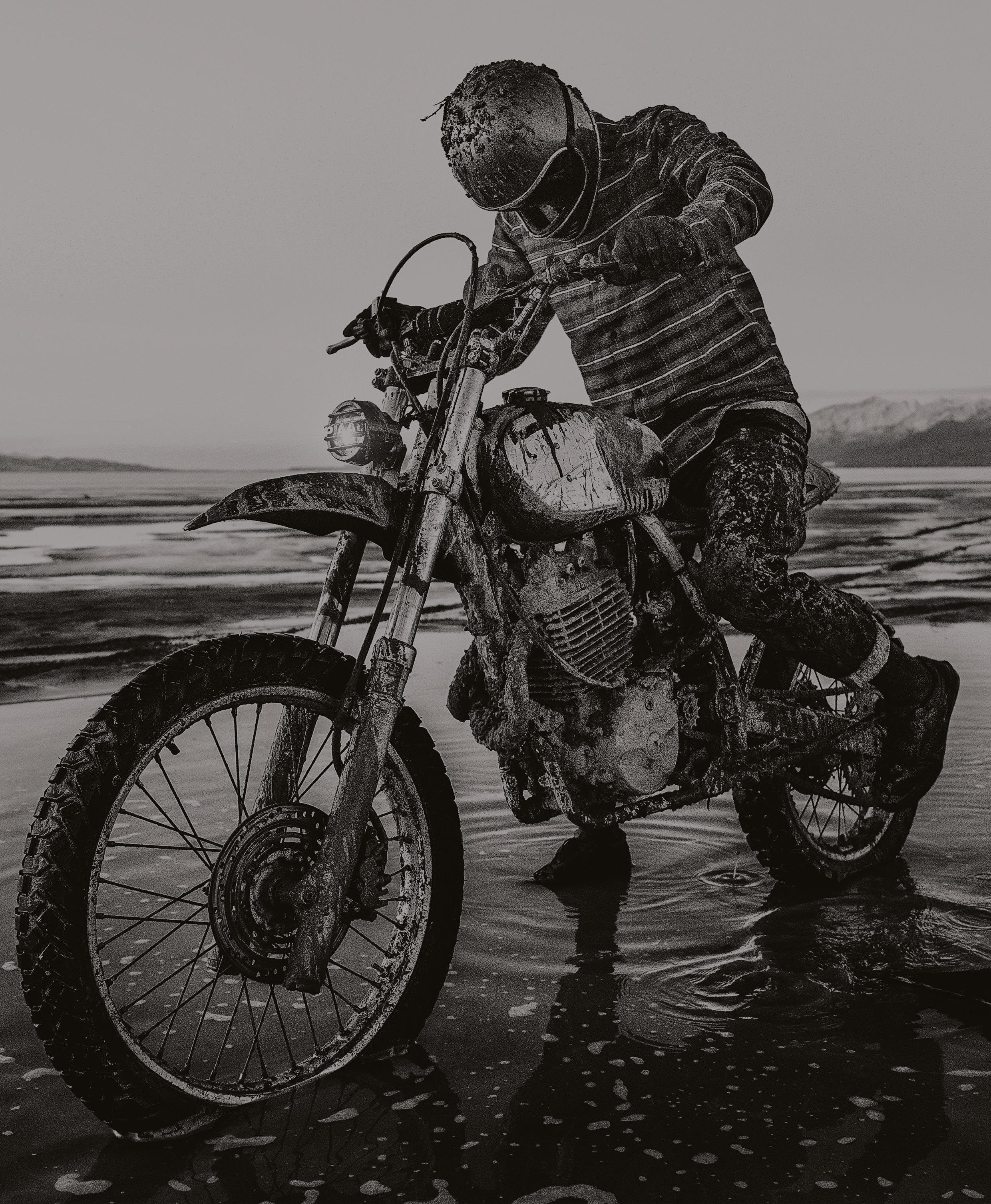












 Words: Bill McDonnell Photos: McDonnell Family Archive
Words: Bill McDonnell Photos: McDonnell Family Archive
33
The 1980 programme for Sidewinders with Brad




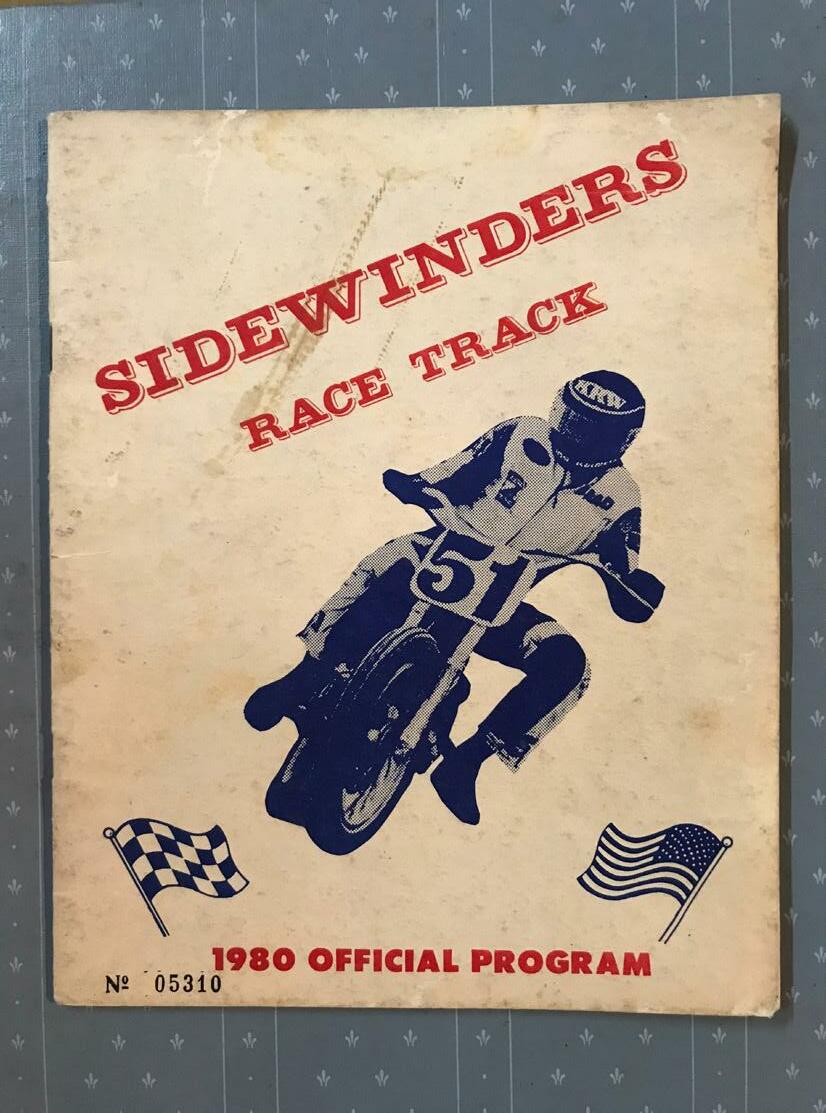
Hurst on the cover. Mount St Helens blew up in May 1980, so there were no races at the Castle Rock that year
Tiny Godel and Tammy Sessions. Tammy was one of the first female pro flat track racers in the history of the AMA. She was from Seattle and raced as a pro from 1974-1976


This is me in 1978. I was 21 and that is a 1977 Bultaco 250 Astro. It is the same make, model, size and year of bike
that I still race now, 42 years later. Last year I raced in SteffanNeilson’s Running of the Bulls series on the West Coast and won the Masters Bultaco




Starting from the top left is my brother, Robert, on a 1977 Bultaco Astro 250. He went on to earn AMA national number 86 in the late 1980s. Currently he is the AMA District 36 Vintage Expert Champion. Top right is me on a 1977 Bultaco Astro 250 as well. At the time of this photo I was an AMA pro novice and later, in the mid-1980s, earned an AMA Grand National #83. Between us is our mother, Linda. She made our leathers right up until she passed away in May 2019.
Next to me is our dad, John McDonnell. He is the reason for us being involved in motorcycle racing. Many of my first memories as a kid are of him taking us to motorcycle and car races all over the country.
In his trunks is John Jr. He was a swimmer, he started when he was eight, at nine he broke the regional record for his age at the 50-yard backstroke and held it for years. Those are his ribbons and medals. John trained for the 1980 Moscow Olympics, but the USA pulled out. Just before the 1984 Olympics he broke his neck in a diving
accident. He currently works for Kaiser Hospitals. Just below Robert is our sister Kathy. At the time of this photo she was ranked #2 girl BMX racer in the USA for her age group. She is now a chef. Bottom left is my brother Michael. He’s on a 1977 Suzuki RM80. At


that time he raced motorcycles and bicycles. In 1986 he was ranked National #1 AMA pro novice. The next year hewas ranked in the top three in AMA Junior Nationals. In 1988 he advanced to Grand National Expert class. He is
currently a sheet metal/ heating and air worker in northern California. Bottom right is my brother Dan, also on a 1977 Suzuki RM80. He too raced motorcycles and bicycles. Dan competed in AMA pro flat track races from the early 1980s to the mid-1990s. Earning national #74. Like Michael, Dan is a sheet metal worker
Regional Championship in Boise, Idaho, around
1980. We met Brad and Tiny Godel in 1983 at Castle Rock.

Tiny was one of Brad’s sponsors and mechanic. He offered us a place to stay while we were racing in the Northwest and that turned into a long-time friendship and sponsorship through his family’s Honda shop in Woodland, WA.
Tiny worked the night shift, so when he got home he would wake us up in many crazy ways. The first morning we stayed with him and his wife, he woke us up by starting a chainsaw in the house! The next morning he used a shotgun, firing it off just outside the room we were sleeping in! I guess he learned that kind of stuff when he was a rodeo clown at horse rodeos. After the second morning we made sure we were awake when he got home
B r a d H u r s t a n d h i s s i st e r a t , I b e l i e v e , t h e N o r t h w e s t
Sidewinders


was a racing club from the Pacific Northwest.
They had a TT racetrack located in Clackamas, Oregon, near Portland. This is the early 1970s. #35 is Randy Skiver, #69 is Sonny Burres, not sure who #67 and #33W are, but maybe Pat Marinacci and Lars Trulson


B r a d H u r s t a t S i d e w i n d e r s i n 1 9 8 1 o n a T r i u m p
My youngest brother, Michael. This was taken in 1986 when he was 16. The track is at
Boise, Idaho, at the AMA TT Western Regional Championship. That year he was ranked #1 pro novice in the nation. He’s racing a Rotax 500 in a Knight frame – and not wearing gloves

The 1991 TT national at Castle Rock. This is the


Dash for Cash, for the six fastest qualifiers. #13 Mickey Fay; #58 Dave Durelle; #19w JoeKopp; #17 Aaron Hill; #74 my brother, Dan. Ican’t make out the rider behind Dan, but I think it’s #1, Chris Carr



M y b r o t h e r, D a n , a t t h e P e o r i a TT nationa l i n 1 9 9 1 . H e ’ s o n a R o t a x 6 0 0



Introducing...
Royal Enfield committed to enter a handful of 2020 AFT Production Twins races with a development of the Harris 650 Twin FT Concept. Covid-19 put the brakes on the project, but their development rider, racer and team manager, Johnny Lewis, tells us he thinks the bike has championship-winning potential

43
Words: Johnny Lewis Photos: Alysha Lewis
>
FIRST RODE
in England, more to actually out the positioning of components concept bike. It’s an amazingly built piece of engineering. There is a lot of adjustment capability built into the concept bike, but I felt it was too narrow around the tank area.
I couldn’t really get my knee to drive into the tank anywhere, so I wouldn’t be able to make the bike turn how I wanted. The seat is too short from tank to over the top of the rear tyre, too. I need more room to be able to get on the rear of the bike to allow a mile tuck position. We spoke about the swingarm and the flex needed as well.

I couldn’t get on a dirt track in the middle of winter in England, but I could ride the bike around an old air force base runway1 and was able to get it up to speed, get in a tuck and feel the stability 100mph. The runway also had a fast left-hand corner that had multiple sealed patches and it was wet from raining earlier in the morning so, at over 60mph and in those conditions, the slick runway felt a lot like the Springfield Mile. I was pleased with the stability at lean, too, even with minimal front-end offset. I was able to suggest other areas to improve the chassis for the next build, removing some pieces of the frame for some flex, changing size on a few tubes…
The engine isn’t as heavy as it looks, I picked it up myself and put it in the frame, since when the concept bike was shipped from the UK to my place in Florida, it was in 50 pieces. The weight is low in the motor and the stock Enfield crank is bigger than that of the Kawasaki or Yamaha twins, so that is a benefit. I feel the motor will be a lot like a big Rotax, just like the Triumph was, but hopefully better. We had some issues with the Triumph when I raced it in 2013, but the team building Royal Enfield engines and I have already listed all those issues and they assure me that this is a much more reliable motor [than the Triumph was, in flat track race spec]. A lot of the engine development guys worked for Triumph, so they should know.
In the short term, the shorter tracks and TT tracks on the AFT schedule will suit the bike best, because those tracks don’t rely on outright power, it’s down to riding a good-handling bike. We are going to have to work hard to get the top speed we need for the miles, but I am confident we will get there. S&S are excited to be part of the programme, too, supplying the exhaust, and have offered me a lot
Appendix
1. Royal Enfield’s UK-based technology centre is next to the Cold War-era Bruntingthorpe air base in Leicestershire. It has long been used by car and motorcycle magazines for speed testing thanks to its nearly two-mile-long runway.
‘We have a programme with a direction and it’s a good feeling’

>
already. We’ve had a few lengthy conversations and they are an amazing crew. I feel we will have a good understanding of what we need to compete against the other production twins.
At the time of writing, I have the concept bike and I’m waiting for the second bike to be built, but riding the concept on my short track has been really good. We don’t have a race motor yet, but just getting an understanding of the chassis has been encouraging.

I think Royal Enfield see flat track as relatable to their road-riding customers in many ways. It’s a simple sport in theory: you go around in a circle, you can do it on almost any bike – it’s just how far you want to push it and how fast you want to go. They are an amazing company, but they’ve never really gone racing. I think they have soul, passion, and if they’re going to put their energy into any sport it’s flat track.
The role I have with Royal Enfield is one I always dreamed of. It’s hard for me to sit back and let others make decisions. I feel like with my experience – not only on track, but growing up with a father like I had, that made me aware of what everything cost all the time, to racing for Factory KTM in the AMA Pro Supermoto series and seeing how a full factory team ran and operated out of a semi truck, to working with so many different flat track teams and mechanics over the last ten years – I have developed a sense of what is a decision for me or the team, or sponsors, and an understanding that balance will benefit everyone. It’s also great to be involved with the Royal Enfield Slide Schools, both in India and America.
My plan for continuing to develop the bike is to get the race motor configuration and the new chassis and start testing on half-miles asap. I’m lucky enough to have access to the Travelers Rest Speedway in South Carolina at any time, so that will be where I’ll be for the first few weeks after I get the goods. From there we shall see, but I feel RE and Harris 2 are giving me a good base and we have the resources to get it dialledin. It has been re-energising to have a budget and connections to make things happen.
I’m back training as if I’m a racer. I’ve always trained, but it has been to just keep in shape, now it’s training to go racing, and racing with a plan, not just a random bike I’ve been offered for one-off weekend. We have a programme with a direction and it’s a good feeling. Who knows, maybe by the time we can go racing again we’ll have the bike where we need it to do a full season, my first full season in American Flat Track.

Appendix 2.
Famed British framemakers, Harris Performance, were acquired by Enfield in May 2015. Their road and race chassis expertise is used by Enfield and Harris made the concept’s frame

Sometimes, it’s all right.

Photo by: @camera.kitWhatever way you go, on whatever bike you do it on, we think it’s all right. Join our strange gang anyplace on this great planet. #seeseeriders www.seeseemotorcycles.com
KOCH JIM
Spokane and San Diego, Haro Bikes and trick fuel shaped the future for this Seattle-based illustrator
 Words: Gary Inman
Words: Gary Inman
49 >
JIM KOCH ENTERED our atmosphere when we saw the poster for the 2020 One Pro flat track races, taking place as part of Portland’s One Motorcycle Show. The poster features three Boba Fett-style biomechanical bounty hunters coming into turn one hot and on the brakes. It’s short track meets Star Wars, really channelling the ‘astro’ in Astrodome. With laser blasters strapped to their thighs and red tracers shining from behind their helmet shields and goggles they have the red mist, a killer instinct, a take-no-prisoners determination and all the other terms used to describe the most extreme emotions racers feel in a firstcorner melee. As an event poster, it’s dynamic and I loved it, but I didn’t know who’d drawn it, which irked me, because I pride myself on having my finger on the pulse.

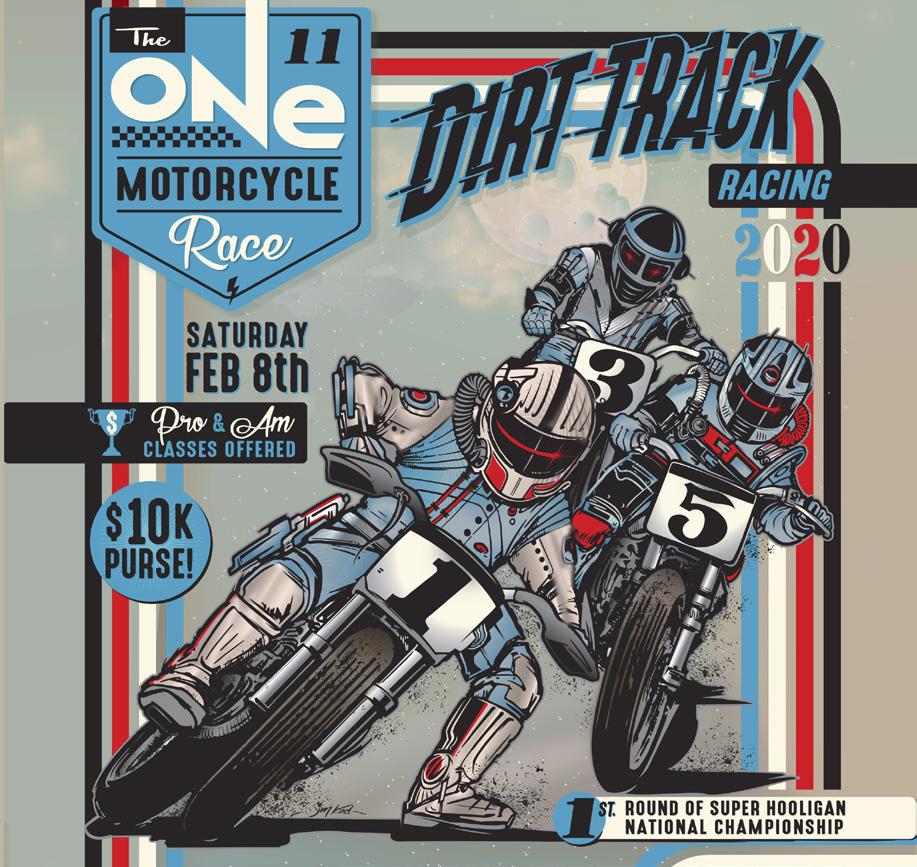

Fast forward a few weeks and I’m in the bowels of Portland’s Veterans Memorial Coliseum, stood behind a couple of borrowed picnic tables covered in Sideburn mags and merch. I’m approached by someone who looks like a Mopar muscle car guy from the early 1990s, perhaps a Gearhead magazine reader.
‘Is there an advert for the One Pro races in the magazine?’ Yeah, issue 39. ‘OK, I’ll have it.’ Can I ask why you want one with the advert? ‘I drew it.’ It’s a hop, skip and jump from that meeting to this feature.


‘I was born and raised in Spokane, Washington, but lived in San Diego for 15 years in the ’90s and I am currently in the Seattle metro area,’ Jim outlines, as he begins sketching out his early life for us. ‘I was always doodling cartoons in grade school. In fact, I was busted in fourth grade for doing graphic specs of Evel Knievel jumping the Grand Canyon: the ramp plans, distance of jump, a technical drawing showing distance and air travel. I was ten years old.
‘There were cartoons and monsters all over my school papers and book covers. That landed me with bad grades and big troubles with Mom and Pop, because all I was doing was drawing. I would try and copy characters from cool magazines like Mad, Monsters of Filmland, CARtoons, CYCLEtoons and DRAGtoons. I would read about the artists who contributed as illustrators and cartoonists. I would follow these artists like other kids would follow pro athletes.’
Not so many years later, pro athletes and outsider art came together in the form of BMX and a young Jim was there to capitalise.
‘As a 14- or 15-year-old punk kid, I discovered screen printing in art studies while in high

(top right) Jim Koch, still waiting for a credible response
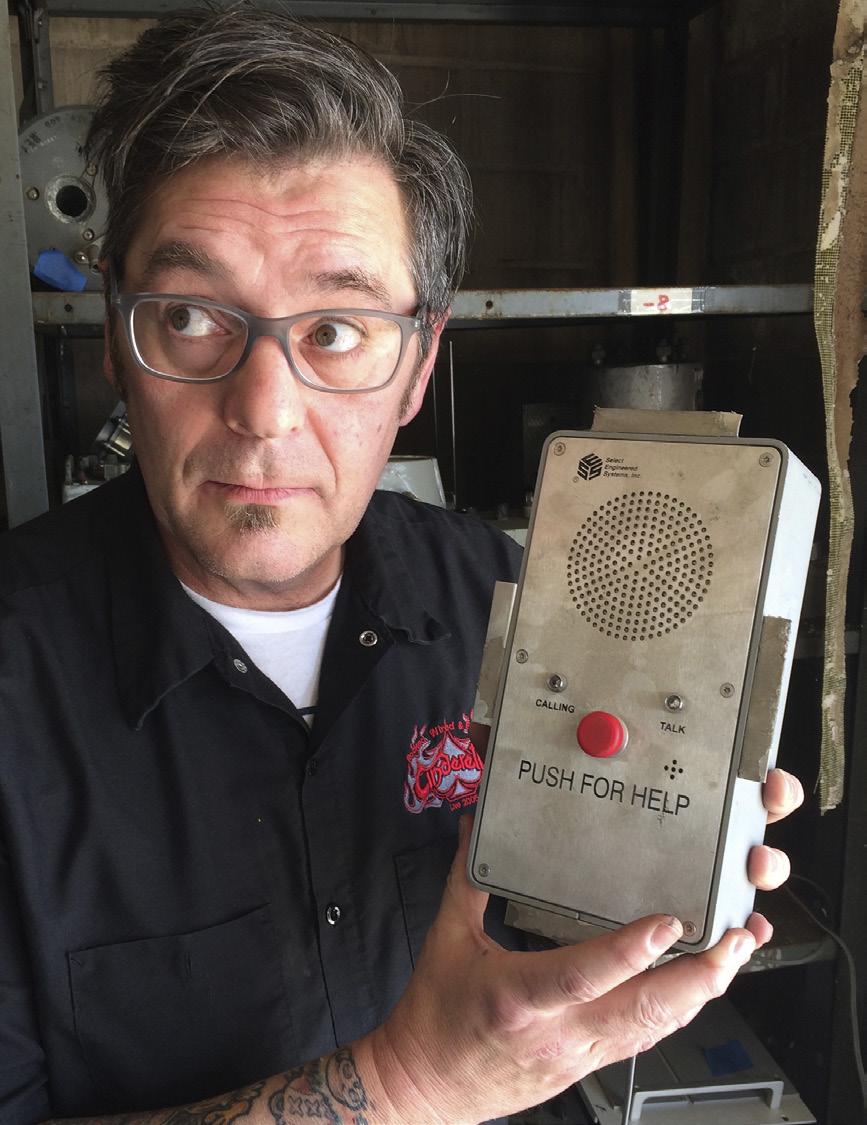
(above) ‘The design above was a small addition to the 2019 PNW/Vintage MX poster I’d done,’ Jim explains, ‘You can see this graphic snuggled in the centre, as a background. I’m a huge fan and collector of vintage MX and BMX apparel kits and race gear’ >







school. I found a job in a T-shirt print shop and learned screen printing and helped all around the shop. [At the same time] I raced for a BMX bike shop and started doing our race team jerseys, stickers and T-shirts. It was exciting when the custom T-shirts started selling in the bike shop, and that was the beginning of it all. After high school I got another job in a cool print shop doing more graphic design and illustration. My boss was an amazing illustrator, he taught me mad skills like design layout, hand-cut film and separations, hand lettering and hyperperspective.’
BMX would also supply one of Jim’s biggest influences, Bob Haro. ‘In the ’70s and ’80s, I followed BMX Action magazine and Bob was the illustrator and cartoon guy. I wanted his job! His hand-drawn creations and the art of BMX freestyle riding [that Haro is credited as pioneering] just blew my mind. I was hooked, grabbed my bike and moved to California. We have become friends since and have done some projects together.’
The seeds of the transition from BMX to motorcycles are traced to a childhood friend.

‘Moto has always been close to my heart. The father of Mike, my best friend growing up, started a cycle salvage yard in Spokane, WA, in the early ’80s. That was a fun place to play and run around in as teenagers. Bikes, trials, BMX and racing were always around. My buddy was, still is, a great flat tracker, trials rider and MX racer. I always tagged along for the races and minibike antics. And my dad used to build NASCAR-style Superstock race cars in our garage. He was on the pit crew as the chief and is an amazing welder and fabricator. I was always playing around muscle cars and hot rods.
‘Our family travelled a lot and toured the circle track race circuit. I have great memories hanging in the race pits atop the ramp truck, sitting on a row of race slicks and smelling the trick fuel burn.’
A T-shirt and sticker graphic for Maxima Racing Oils’ Castor 927 for two-strokes
I raced for a BMX bike shop and started doing our race team jerseys, stickers and T-shirts

>
When it’s time to call on those decades of high-octane inspiration Jim holes up in his home studio. ‘Generally, I collect a load of images to get the inspiration rolling. I crank the music and make pencil sketches with notes. I do a few loose, black-line drawings on a light table from the sketches, then a few real clean redraws before the design goes into the Mac. I tweak and pull for a few hours to get my black line just right with no kinks. My take is to make it look like the original illustration I did on paper, but more dynamic and fitting for the project. I also try and remove the look of computer the best I can. ‘I juggle a few projects at all times. I enjoy rolling like this, so I can bounce from each project and not burn out on a character or text. Each design or project takes a few weeks, unless I’m waiting on additions for a poster or something like that. I don’t like to stagger too long on posters or graphics.’
Jim is especially proud of a recent motorcycle race poster. ‘It was for 2019 VMX, a vintage motocross gathering at the Washougal track in the Pacific Northwest. For the design, I did some vintage helmet graphic replicas of famous MX racers. Each racer on

the poster was at the event and it was great to meet them, shake hands and get some prints signed. That was a hard design to pull off.’
With so many moto events and brands choosing to use artists to create their promotional material I wonder why Jim thinks illustration is getting the better of photography.
‘A photograph captures a moment in time,’ he says. ‘An Illustration offers infographics, and a creative interpretation of that moment in time.’

I had a hunch I’d like whoever created the One Pro race poster and it’s confirmed when Jim explains where he likes seeing his artwork the most.
‘Print media is rad. It’s always a treat to see my graphics in full-colour print, like a magazine, catalogue or book. I really enjoy doing gig posters and meeting a band who get excited and appreciate it. Doing the design itself is always cool, but to see it custom printed is a thrill.’
Amen, Jim. Amen.
‘A graphic I had made for a digital print to coincide with an art exhibit I was part of in 2018. This print is available in my Etsy store’

SWAGGER

Words:
Gary Inman
Photos:
Tom
BingOne of the defining pillars of Sideburn style,Jacopo Monti does hooligan racing with Italian flair

57 >
LIKE A HOLIDAY waiter charming your girlfriend while you blink with openmouthed disbelief, Jacopo Monti slides into English flat track pits with a looselimbed insouciance and half-cocked eyebrow above a pair of metal-framed Ray-Bans. In black leathers, disco-ball Bell and decades-old hot shoe he walks with a studied simian swagger. Next stop: podium. He isn’t one of the Europeans who fly in and out, would-be pro style. Neither is his cross-continental road tripping carried out in the cruise-controlled, six-wheeled comfort of a climate-controlled off-white Winnebago. He arrives, more often than not, in a dishevelled Iveco, sometimes with an ancient moped or some other antique he’s bought on his travels through France, to sell when he gets back home. Hung in the back of the van is the Marlboro racing jacket he bought from David Aldana. If he has time, he cooks a big meal, with a Monte Bianco of fresh salad, for his British friends.
Monti is one the handful of European racers who were influential in the formation of Sideburn and the way we continue to view the go fast, turn left world. Along with fellow Italian Marco Belli, Brit Peter Boast and Dutch Brother Jan-Willem Jansen, Monti helped set the tone for Sideburn, with his commitment, passion, style and willingness to travel thousands of miles for a day’s amateur racing.
Though Italy has a history of speedway, Jacopo is one of the first generation of flat track Italians, dating back to the early 1990s when the tiny flat track community was given a massive boost by the then national Harley-Davidson importer. Harley Italy commissioned the building of 20 Wood Rotax framers and then, in 1990-’91 invited the top US riders of the day, including Parker, Carr and Atherton, to come to Italy and race local riders. The event was on Italian national TV. Jacopo wasn’t in that race, but he was already racing flat track, one of those Italian originals, at a time when Euros were in love with superbikes and supermotos. He remembers, ‘My first race was at Levane, Tuscany, on a two-stroke Yamaha 250cc. I finished 13th out of 13. I still have the bike, in perfect working order, with the yellow colours of Kenny Roberts.’
In 1996, the same Harley importer created an 883R Short Track Trophy, similar to those running in the US. ‘In 1996 I was in the military, it was compulsory, and after my first three weeks, instead of going

home with my first weekend licence, I went to race a Sportster in Badia Calavena on a bike loaned to me by the Harley-Davidson Mantova dealership.’
When I first met Jacopo, almost a decade later, he was racing a Wood Rotax, one of those left over from the 1993 Italian race series, and travelling from northern Italy to the UK, a 2000-mile round trip, for an afternoon’s amateur racing with Peter Boast’s fledgling Short Track UK series, at the time the only flat track series in Europe. I remember him driving that distance for a race, in the 2007 season at Redcar in the north of England, that was rained-off. He responded with a shrug and drove home. As cool as you like. His working-class Italian style is tinged with a sense of humour. He is almost always on the podium, and appears for his plastic trophy in a dressing gown, or a cheesecloth shirt and jeans with a towel wrapped around his neck like a scarf to allow him to cope with the chill of a Northern European evening. One set of black leathers he wore for a season or two was made to look like a tuxedo, with a white shirt and black bow tie, and yes, his race bike was bubblegum pink.
This all explains that the current wave of hooligan racing is not Jacopo’s first road bike rodeo, there’s just been a 25-year gap.
‘This bike belongs to Andrea Rivolta, owner of a beautiful Harley-Davidson store in Milan,’ says Monti. ‘Andrea knew my name from old magazines and, despite my bad reputation, asked me to race it in the European and the Swiss championships. He gave me the utmost confidence and followed every technical request I gave him.’
The bike is a 2002 model with an S&S 1200cc hooligan kit, Screaming Eagle carb, K&N filter and SuperTrapp exhaust. The suspension is top-of-the-range Öhlins, wheels are from Borrani and the brake was sourced from Sportster specialists Storz. Andrea, who is Jacopo’s sponsor, made the seat and tank himself.
Jacopo and Andrea arrived at Greenfield for the UK round of the 2019 European Hooligan championship, 950 miles from Milan, ready to race on Saturday. Unfortunately, his race wasn’t until Sunday. The pair hastily reorganised ferries and Monti was able to continue his long run of UK podiums with a stylish second behind Ducati Scrambler-mounted UK and Euro Hooligan champ, Gary Birtwistle. When it came to the sun-drenched prize-giving he kept the crowd waiting, appearing with a cocktail, in sunglasses, the sleeves of his linen shirt flapping. When it comes to swagger, no one can beat Jacopo Monti.
First Lady, named in honour of Melania Trump. Or not
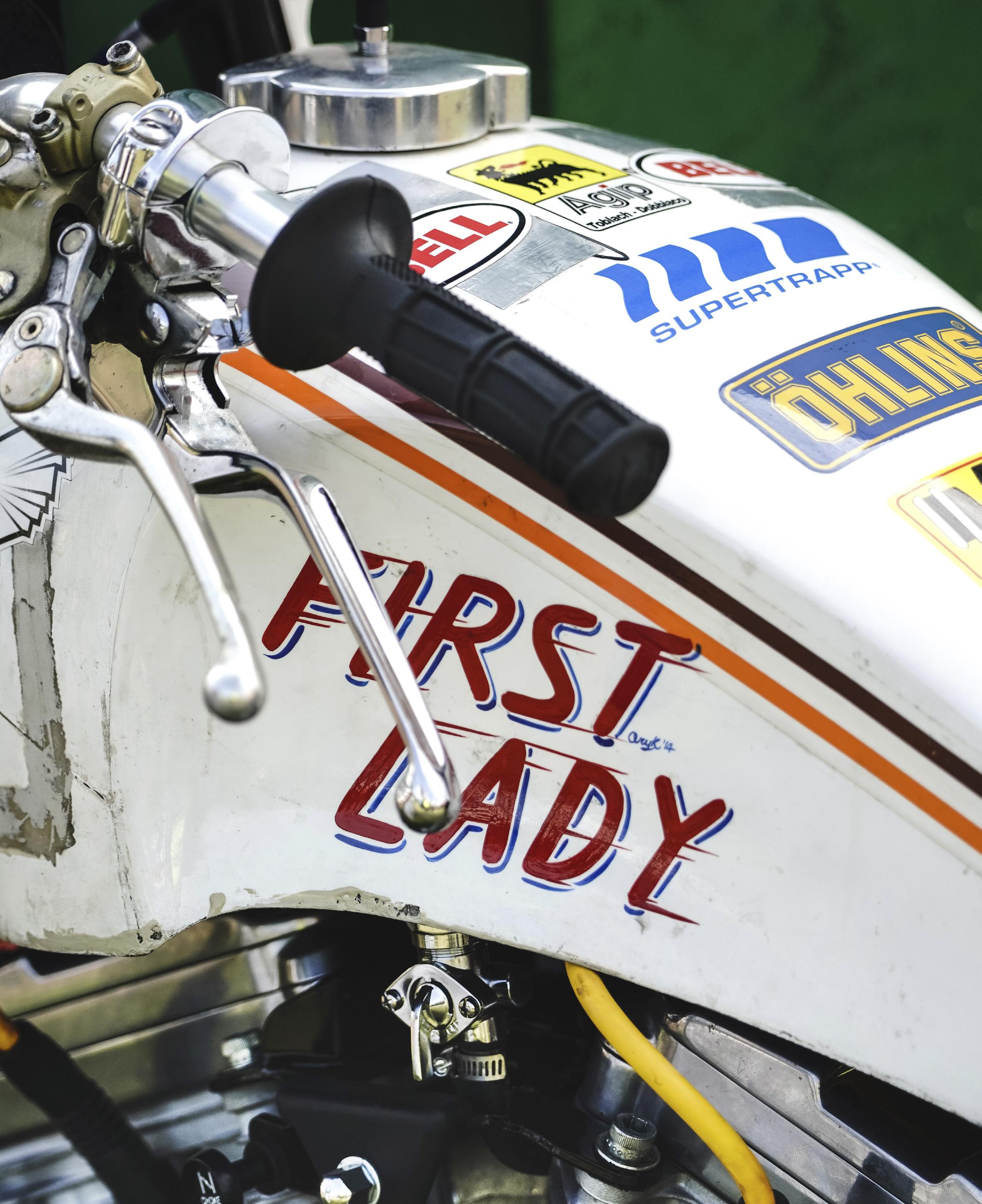
1988, Dave Miller leads the pack, hanging it out in supreme style, high enough up the track to smell the crowd leaning on the flimsy chainlink

The
Barbara Fritchie Classic
Words: Ted Ellis Photos: Flat Trak Fotos
A half-mile of Maryland dirt with almost a century of sliding to celebrate

61 >
THERE IS A sacred day in America. Not merely a day, but rather a date. Never a simple extension of the weekend. Some years it’s on a Wednesday and everyone goes back to work the next day. It’s a date not a day. An obligation, not a convenience. The 4th of July, American Independence Day, the high point of the summer. It’s the country’s birthday, of course, but it’s even more important than that.

The 4th of July is when the Barbara Fritchie Classic motorcycle race takes place in Frederick, Maryland. This isn’t just any race. It’s not even a national, the track is slightly too narrow between turns 3 and 4 to host the AFT series. No, to those who know the Fritchie, and those who have it on their bucket lists, it’s an icon. This year’s event will be the 99th annual race on the same halfmile grey limestone cushion track. But the Fritchie isn’t merely a race, it’s a tradition. The history of the Barbara Fritchie Classic is the history of flat track racing.

Frederick, Maryland, was once the gateway to the first Wild West in 1755, when England and France were fighting over who got to keep America. That didn’t work out so well for either side, but we’re all friends now, so let’s race!
Not so fast. Who is this Barbara? Not some biker babe. Seems there was another war about 100 years after that Independence scuffle. When General Stonewall Jackson’s Confederate army was marching through Frederick during the civil war, everyone rolled up their Union flags and hid them under the bed. Everyone except Barbara. She was 96 years old. What did she have to lose? Barb leaned out of her attic window and waved her flag while hurling insults at the rebel soldiers walking by. A year later, a guy named John Whittier wrote a poem about her. It’s a big deal around my way. I’ll let you google it if you want to know more.
Fast forward to 1918, when two brothers, Paul and Chester Delphey, opened a Harley-Davidson shop in Frederick, three doors down the street from where Barbara Fritchie had lived. Business was a little slow, so in 1921 Chester arranged for a race at the local fairground, featuring a rivalry with the Brish brothers’ Indian dealership from across town. The Brish brothers seem not to have fared very well and the Delpheys took the race on themselves for the next 35 years. In 1956, the Delpheys handed it over to a local branch of the Lions Club, to fund the club’s benevolent activities. It was the Lions Club who established the name of the race as the Barbara Fritchie Classic. In the early days, the date on which it was run bounced between various patriotic holidays such as Armistice Day, Decoration Day and finally Independence Day, but for most of its history it’s been held on, or as near as possible to, July 4th. Virtually every race for more than two generations has been on this now traditional date.
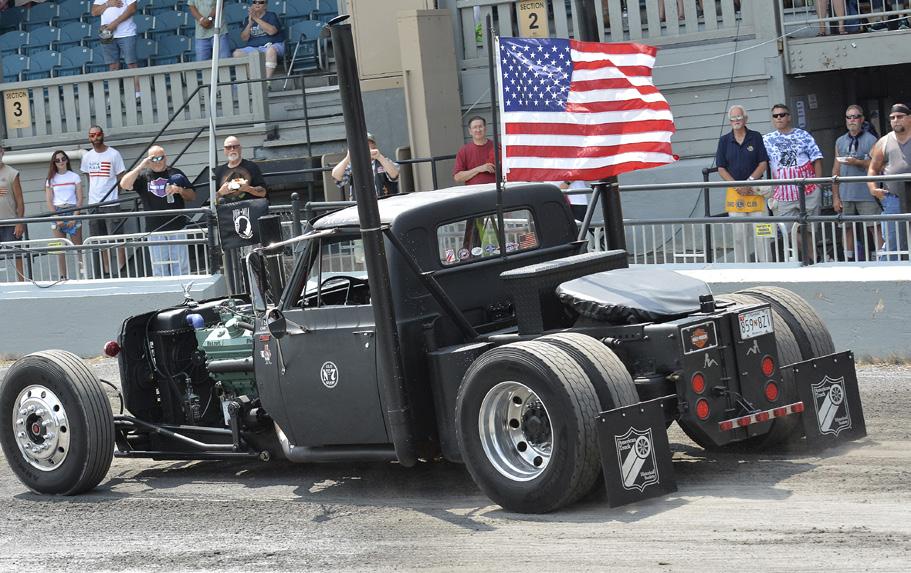
About a decade ago, the Lions Club decided to stop hosting the event. Rather than see it die so near to its
(above from top) Stars, bars and sunburnt shoulders; Local Maryland rider, Dalton Winkler, obeying the signs; Mutant course car/tyre packer/ six-wheeled troublestarter. (overleaf) Sammy Halbert leads a field of national numbers in 2017, on a dry and dusty track. Halbert is wearing Estenson leathers, but is riding Baer Motorsport’s KTM 1000 V-twin. Jeffrey Carver, 23, ran him close for second, Chad Cose, 49, was third, both on Kawasaki twins
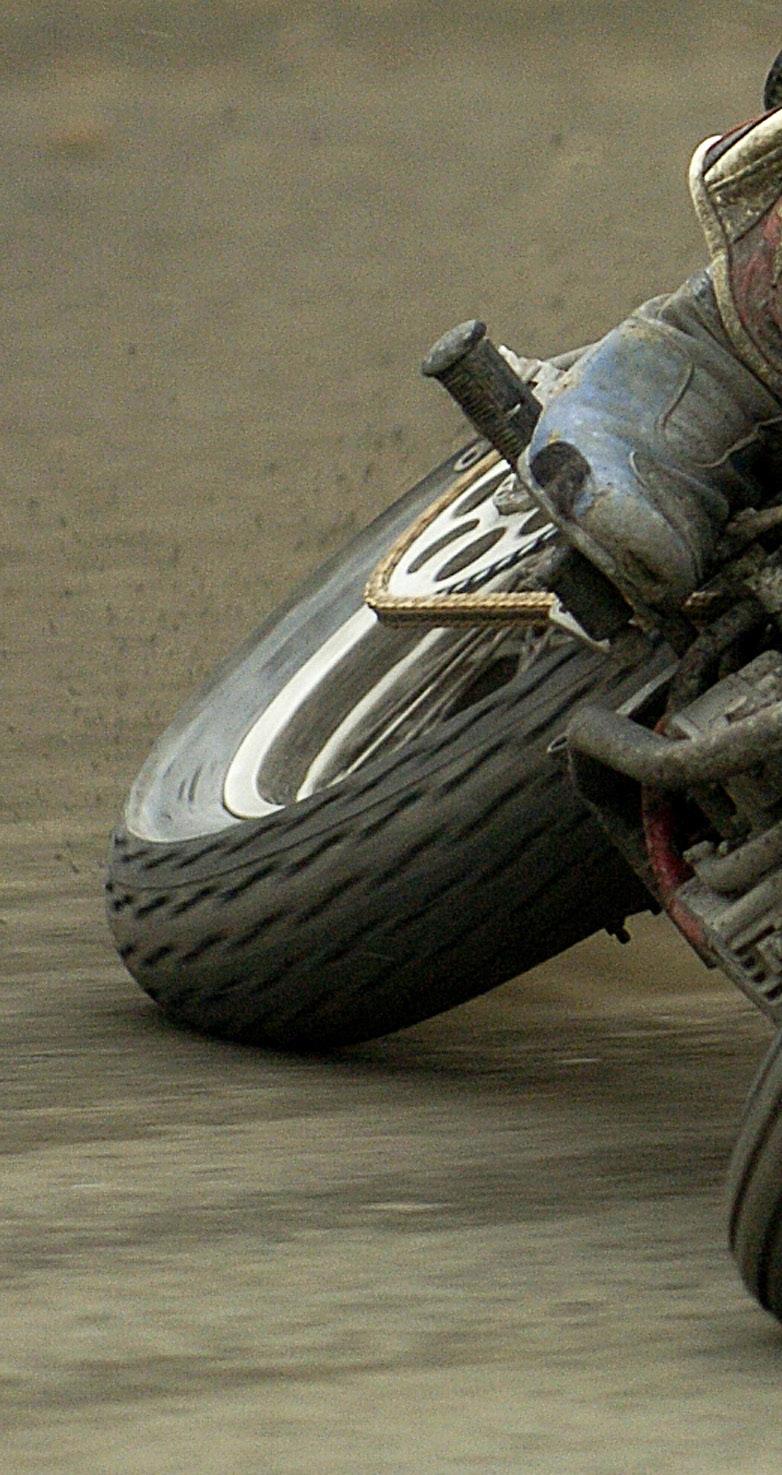
Ohio’s Dan Gedeon, in ’07 on the Maryland cushion. Must have felt a lot like his home state’s tracks

>


Frederick is hallowed ground in flat track racing >
(clockwise from top left) Mike Poe; Nature’s airfence; Jared celebrating in ’07; Our own Cory Texter, #65, in 2009
100th year, Frederick Yamaha dealer, Richard Riley, mortgaged his house and reluctantly became a race promoter. He bet all the marbles on the fickle July weather and his sons being able to sell enough tickets to pay the bills. This wasn’t business. This was love.
When the Barbara Fritchie Classic was born, racing was already wildly popular. There were hundreds of tracks around the US, both dirt and boards, and there have been hundreds more since. But this one, the Frederick half-mile, is the same track and has hosted the race every year since the event’s birth in 1921, except for three years during WWII, when there was no racing anywhere in the USA. And motorcycle races had been held on this track by other promoters for at least a decade before that, frequently several per year, including national, regional and state championships. Motorcycle

racing at the Frederick Fairground has been staged annually for only five years less than the Isle of Man TT, and even the TT cannot claim the exact same course throughout the years.




This is hallowed ground in flat track racing. Frederick, Maryland is deserving of its place among such icons as Springfield, Illinois; Sturgis, South Dakota; Oklahoma City; Stockton, Kansas; Peoria, Illinois and Sacramento, California. It is where thousands of riders, both famous and unknown, have hung it all out.
At present, it remains unclear what will happen after number 100 is in the books. A lot of effort and money goes into a race of this stature and nobody is getting rich from it. Flat track racing is tradition and tradition is epitomised at the Barbara Fritchie Classic, and for now we look forward to number 99.

ACOUPLE OF blokes rip trailbikes round a disused quarry. They blast past a Range Rover with a picnic laid out on its bonnet as a fragrant young woman waves and smiles. We’re seconds into Silver Dream Racer and this British film is already stretching the bounds of belief. Moments later, one of the riders crashes and dies instantly of a bruised shoulder. That noise? Suspended disbelief smashing into a thousand pieces as it hits the ground.
Back when this was filmed, in 1979, if I’d been lucky enough to tear-arse around a quarry on a trailbike, chances are I’d have been harried from all sides by a gang of urchins on stripped step-thru field bikes with open pipes. And had my girlfriend deigned to come along, she’d most likely be sat with her mate, bored and uncomfortable, and greeted me as I passed with blunt obscenities expressing her desire to go effin’ home.
We need to have a think about the world into which Silver Dream Racer was launched. The film’s star,


David Essex was a British phenomenon, little-known outside the UK, and as such the main target for the film was a UK audience. Biking back in spring 1980, when the film was released in the UK, was vibrant, with learner riders allowed to ride 90mph 250a so long as they displayed L-plates; bikes like Yamaha’s RD250, Suzuki’s X7 and Kawasaki’s KH250.
There was a strong culture around the bike scene, a scene dominated by relatively young blokes paying off their GT750s and Z1000s on hire purchase. And it was a hairy, macho crowd; moustaches were rife, and black leather jackets typical, worn with jeans tucked into high boots with white socks turned over the top, either those or eight-hole Doc Marten’s or Adidas Samba trainers.
The pungent aroma? That’ll be a mixture of patchouli and two-stroke exhaust, a smell almost as loud as the music on the pub jukeboxes, loaded with tracks from recent albums such as AC/DC’s Highway to Hell; Motörhead’s Overkill and Bomber; Saxon’s eponymous debut; Whitesnake, Judas Priest, Black Sabbath, Iron Maiden... It was a beery era of oily fingernails, grimy Wranglers and long, tangled locks
Words: Mick Phillips Illustration: Raid71
Pop star cash-in or gritty reflection of the brutal world of motorcycle racing? Silver Dream Racer rarely divides the critics

> 69
flapping from beneath Griffin, Kangol and Stadium full-face helmets with easy-scuff visors almost opaque from a fog of ultra-fine scratches.

David Essex, though a motorcyclist, was not of that world. He was a pin-up for teen girls; a bit like David Cassidy in the States. At the time of the film’s release, he’d had seven UK top-ten pop hits, including two number ones. He wrote the music for the film, including the main theme, Silver Dream Machine, which peaked at number four in the UK charts in spring 1980. Also like Cassidy, he combined a pop career with acting and had starred in, most notably, the
music-based That’ll Be The Day and Stardust. He was a big name, but of no interest to typical British bikers. Your mum might have fancied him though.
So OK, perhaps the film was aimed at road-race fans. But really? Any film would have had difficulty creating a stronger character than Britain’s twotime world champion Barry Sheene, a household name still running at the top of the 500 class. Gifted, showy, gobby, loveable, detestable, colourful... When not recovering with astonishing speed from bodysmashing crashes, he was living a rock star’s life with model and former Penthouse Pet, Stephanie McLean.

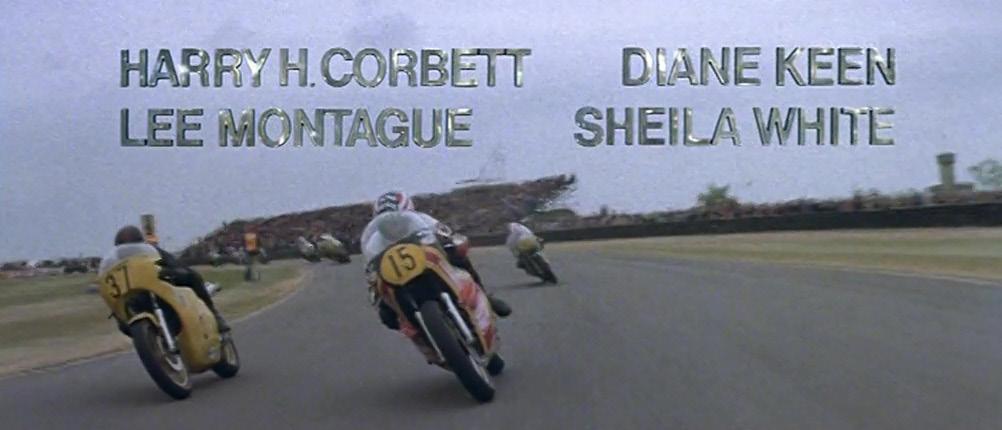
A high percentage of the film’s budget was spent on Vaseline for smearing on the camera lens at strategic moments. 1980s period detail freaks will be ecstatic. Looks like the Bike Shed on a Saturday morning
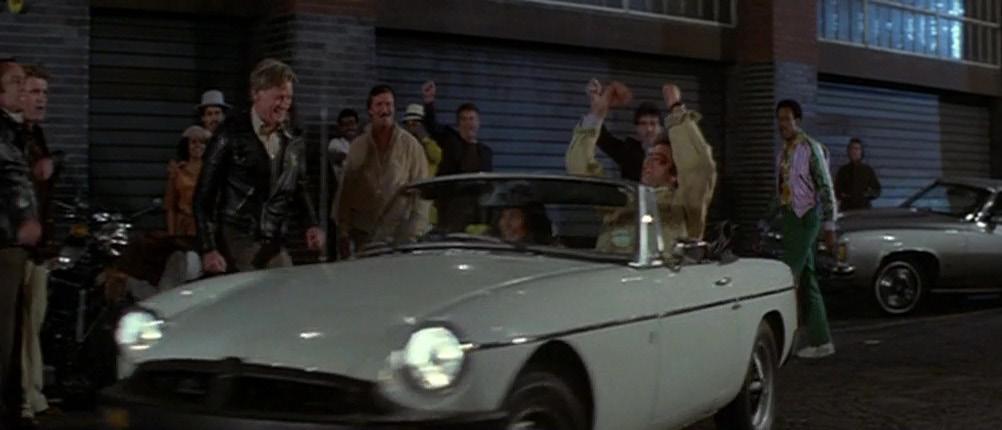

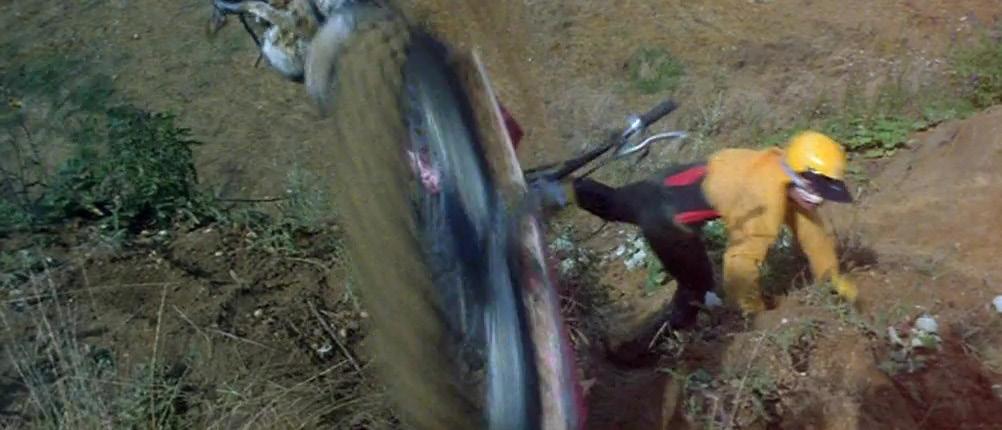



Add to this mix a certain Kenny Roberts. He’d been almost unknown to Brits, ignorant of his flat track prowess, but when Yamaha turned their attention – and Roberts – to road racing, he denied Sheene a third consecutive title by winning the 1978 500cc world championship in his rookie season. Consequently, 1979’s British Grand Prix turned out to be a real crowd pleaser, played out between these two superstar rivals, creating one of the most memorable, folkloric encounters in road racing history. Strangely enough, although few films, let alone Silver Dream Racer, could compete with such real-life drama, the bike – Silver Dream – actually existed as a racing entity, was on the track that day and the film crew was there to capture it.
Well before the film’s gestation, the bike was a development racer built by small, independent British firm Barton Motors. The majority of Essex’s riding shots actually feature leading British racer Roger Marshall 1 in the saddle. The director, David Wickes, was keen to get real race footage and so the bike was entered in the grand prix at Silverstone.

Apparently, Wickes was crestfallen to be told that it was unlikely the bike could win the race, despite Marshall’s talents, given the combined might of the Suzuki and Yamaha factory teams, spearheaded by Sheene and Roberts.



As it turned out, Marshall managed to qualify midfield (though some say a rule-breaking 750cc engine was slotted in to make the bike vaguely competitive) but was put out of the race by a fuel leak. Desperate to get a shot of the bike crossing the line, the filmmakers managed to sweet-talk the organisers into letting Marshall back out on the last lap, ushered onto the track between packs of racers.
And so to the film itself. Essex plays cash-strapped racer Nick Freeman, struggling to realise his talents on shonky old machinery. Things start well, with sweeping aerial shots of two lads on trailbikes in a quarry, larks that will lead to that fatal shoulder injury. Next, as the opening titles roll, we get some pretty good on-bike action shots taken at Donington Park during a Transatlantic Match Race. In fact, throughout the film we get real race footage here and there and it’s hypnotic to hear big two-strokes being caned, even if the audio doesn’t always match the gear changes. Mind you, we often switch to poor bluescreen work of Nick and American baddie, Bruce McBride (Beau Bridges) swaying about on clearly static bikes like kids on a ride outside a sweet shop. As the opening sequence closes, Nick is challenging for the lead when his engine blows, handing glitzy McBride on his factory machinery the victory. Nick has a moan at his loyal mechanic, the strangelynamed Cider, before setting off home.
Appendix


1
Roger Marshall was one of the stars of his generation of British road racing, competing for Suzuki and Honda factory teams in both F1 and on the roads. His son, Adam, has raced in the UK dirt track series and is a mechanic for Tom Neave’s official Honda British Superstock 1000 team.
>
It’s only when he gets home that Nick learns of his brother’s death in that nasty quarry-based shoulderbruising incident. It soon turns out that his grieving sister-in-law wants shot of a bike that’s cluttering up the garage. Enter Silver Dream, which in fairness looks pretty good 40 years on. Clearly, Nick and his brother had a pretty poor relationship, given that he had no idea about this advanced bit of road-race kit was sitting under a sheet in the garage.
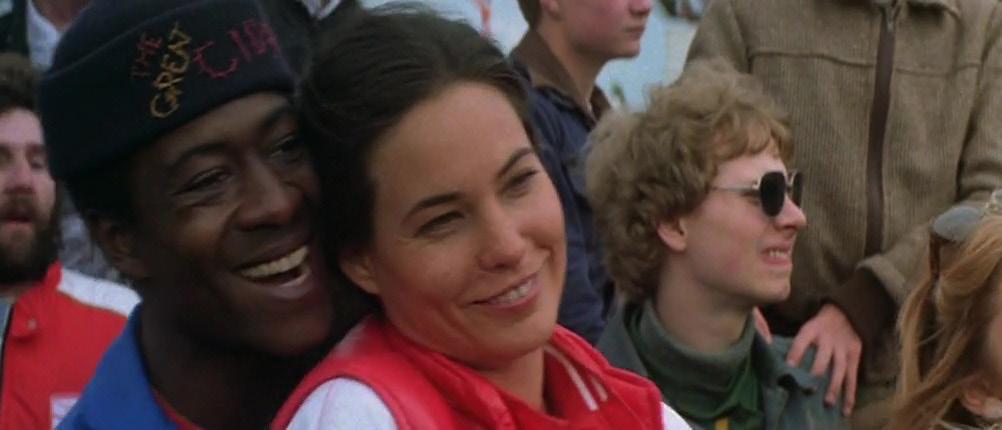
The story now clicks into predictable fare, though Essex generally sounds as if he’s talking in a coo-coo voice to a baby and whose oft-used ‘pensive’ look could easily be interpreted as that of someone who’s forgotten why they’ve walked into a room. So, man obsessed by racing. Man’s girlfriend walks out, sick of playing second fiddle and never knowing if she’ll see her man alive again when he leaves for a race meeting. Man meets soft-focus girl with little stars that glimmer in her hair. Girl understands man and shares his racing dream. Woman sustains man, body and soul, including gallons of orange juice at every breakfast and a tough exercise routine at an abandoned airfield involving


both vertical and horizontal jogging. Man pursues dream against the forces of evil. Man wins in the end... or does he?
It’s worth watching the film if only for the nostalgia, for those two-strokes, for spotting famous racers in the real race footage. Look out for Mick Grant crashing out of the race at the end of the film on Honda’s exotic, never-competitive, oval-pistoned fourstroke NR500 when it pissed oil all over his back tyre. Although the editing makes it seem otherwise, the bike dumped Grant on his arse and burst into flames on the first lap of the British Grand Prix.
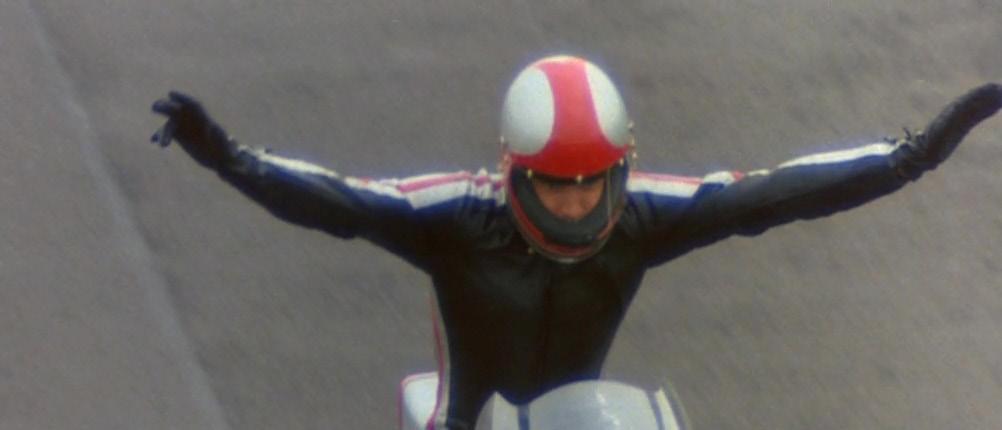

There are two ends to the story, the UK version and the one for the USA release. In case you haven’t seen the film and find yourself still in lockdown, race bike in the garage and no racing even on the telly, I won’t spoil it. Suffice to say, they must have thought the Brits had stronger stomachs. At time of writing, you can catch the full UK version on YouTube. If you want the US edit, just pause it at 1h 44m 26s.

‘Man pursues dream against the forces of evil. Man wins in the end... or does he?’

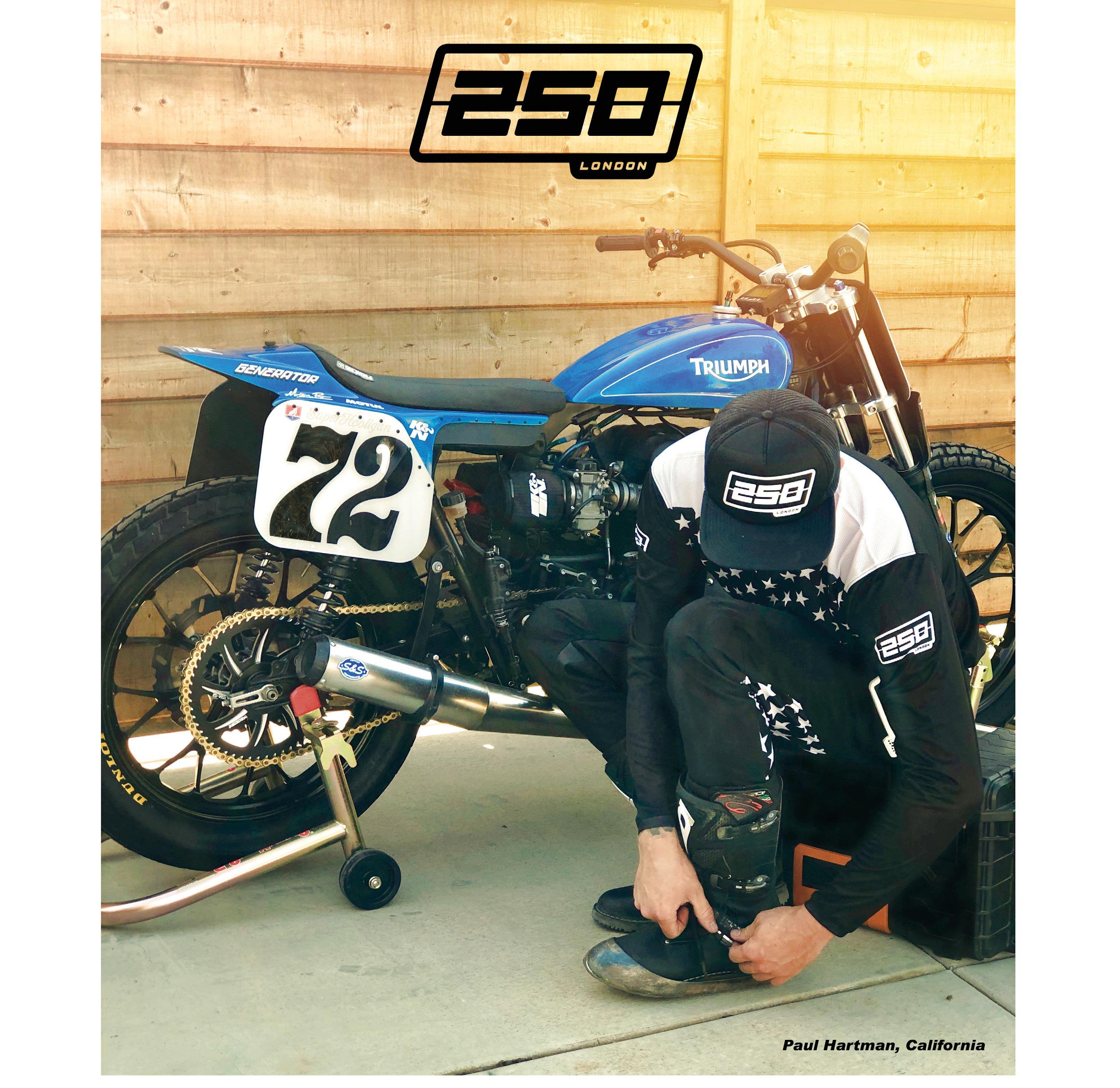

York
NUMBERS
Among Damon York’s huge collection of dirt track memorabilia are dozens of signed number plates. These are some of his favourites
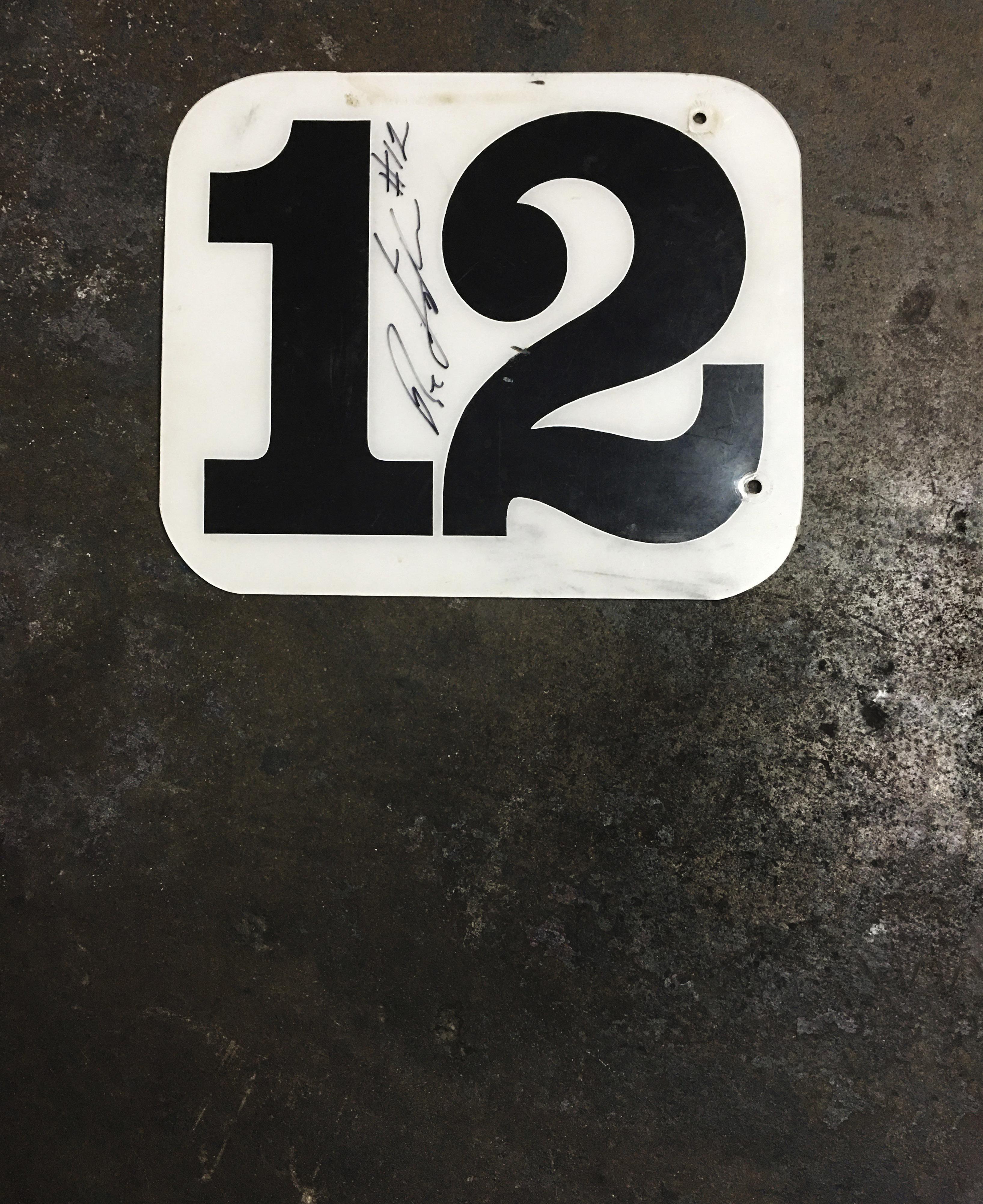
#12
Rex Fisher
Held this national number: 1990-2000
REX IS DAVIS Fisher’s pop. I bought this at a yard sale somewhere in Orange County, California. It’s a normal plastic plate that was run in early 1990-ish. It was used on a race bike and was already signed on the back by Rex, Springsteen, Carr and Charlie ‘Chas’ Roberts. I took the plate to the 2018 Sacramento Mile and during the pit walk tracked down Rex doing a gearing change on Davis’s bike. There was a line of meet-and-greet fans for Davis, but I stuck my head in the tented area and called, ‘Hey Rex! Can ya sign this plate for me?’ He looked up, kinda annoyed, thinking maybe it was a joke, but when he saw me holding this plate he smiled ear to ear and yelled over to his son, ‘Hey Davis! You ain’t the only one signing stuff today!’ Davis looked over, Rex flashed him the plate and Davis laughed.
MAGIC
Words & photos: Damon
75
>
Morehead
national number:
AN OLD GIRLFRIEND gave me a set of three Morehead plates for Christmas one year, two were metal and one was plastic, all heavily used, from the same bike. This particular plate is one of my favourites. Not only is it from one of my favourite riders, the ‘Findlay Flyer’, but the battle scars show what warriors these guys are. This is obviously a side plate that has a slight bend to contour to the bike. I took it with me up north to the Sacramento Mile and tracked down Morehead during an intermission. As you can imagine, that dude is going
100mph all the time trying to make the big show happen [Morehead is AFT’s Track Director]. I spotted him and called his name. He turns around, looks at the plate, rips off his headset and says with a huge smile, ‘Look at those tyre marks! That’s a good one.’ He takes my shoulder, flips me around and places the plate on my back to sign it. He turns me back around to shake my hand and tells me, ‘Thank you’. Everyone starts yelling at him again about getting the show on the road. As I walk away he winks and gets right back to work not skipping a beat.

#42 Steve
Held this
1975-2000
#16
Ronnie Jones
Held this national number: 1980-2000 and 2019-2020
I BOUGHT THIS plate a few years back at an antique store in Oklahoma City, where I have family. As you probably know by now, any time I go to a national race I look at my plate collection to see which ones I should take with me. I took this one to the 2017 Calistoga HalfMile. Once I found Ronnie, I said, ‘Hey Mr. Jones, can ya sign this plate?’ He turns around and says, ‘Wow! Look at that Ascot shirt!’ and removes his jacket to
show me he has the exact same shirt on. Ronnie won the very last motorcycle race at Ascot Park in 1990. He took the plate, looked at it, and looked at me like, Where in the hell did this kid get this plate? Ronnie is from Oklahoma City, where I got the plate. Then he signed it and told me, ‘Thank you’. If I remember correctly, he was either running a team that day or racing. He disappeared as soon as he’d appeared.

>
#20
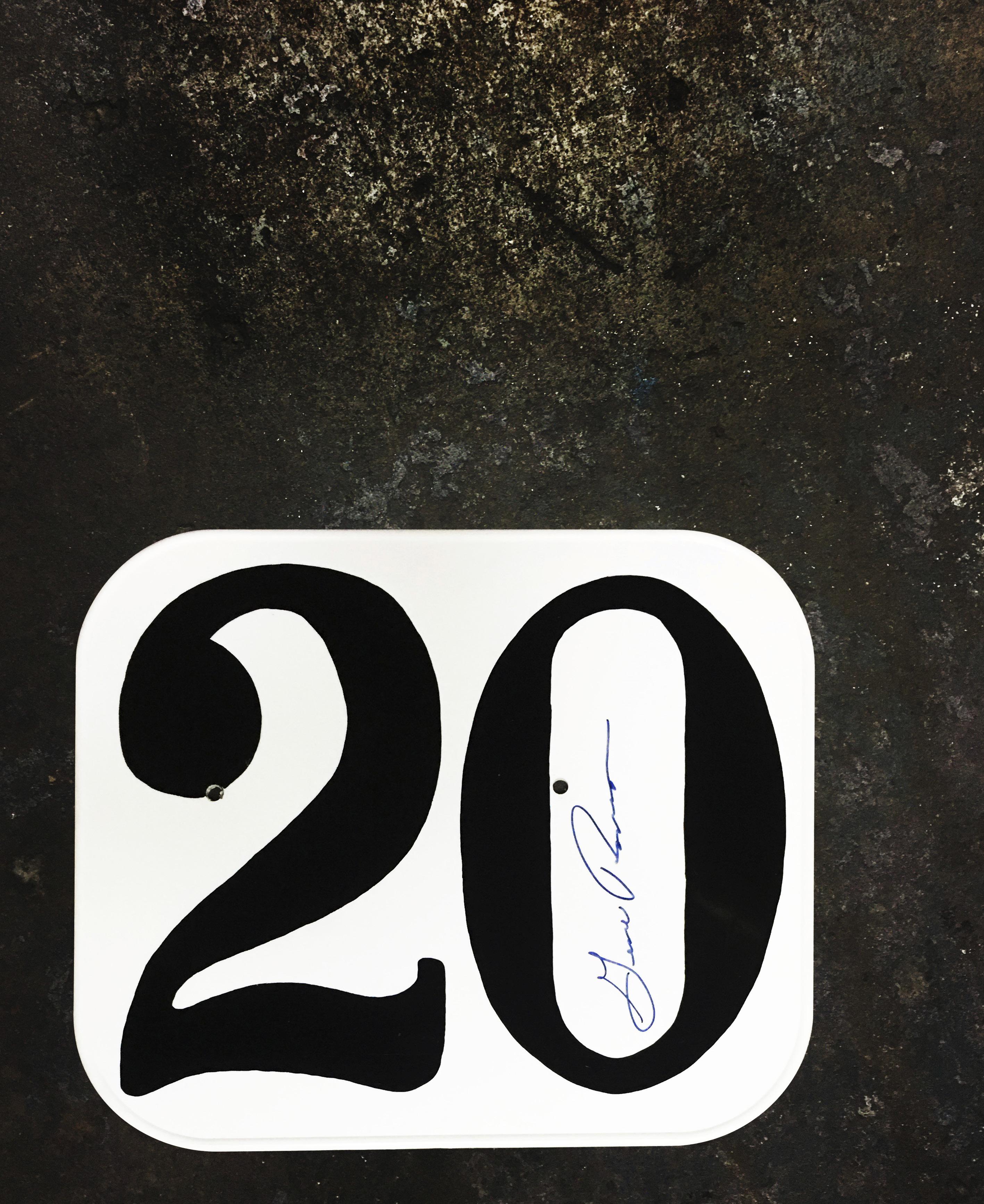
Gene Romero
Held this national number: 1967-1969
THIS WAS AN old plastic plate laying around my shop on a back shelf. I had acquired one of Gene’s old #20 Triumph Sonicwelds from Don Miller at Metro Racing. With the bike came extra cans of 1950 Dodge paint, several pictures of Gene riding the bike, old tail section and stencil numbers two and zero. I was a week away from going to the 2017 Perris Half-Mile. I knew Gene was going to be at the race and decided to clean up and paint the old plastic plate using the stencils that came with his bike. The following week, my girlfriend at the time and I headed out to Perris.
We got there and I saw Gene sitting up at the bar area talking to an old buddy. As I approach him with the plate, he’s finishing a story by saying ‘…and all I know is my shoe had come off my boot a few laps ago and now it’s slapping me on the shin.’ He looked at the plate, looked up at me, smiled and then saw my girlfriend. He was happy when he saw that painted plate, but lost interest once he saw what my girlfriend was wearing: short shorts, long tube socks and a tank top. He had that Gene Romero smile that I’ll never forget. He still was the man!
#14A
Dalton Gauthier
Held this number: 2016
I’VE ALWAYS ROOTED for Dalton and I got this plate from Miriam Deitcher at Flat Track Live. It’s the front plate from his bike at Eddie Mulder’s West Coast Dirt Track Series, from 2016 I think. In 2019, the #14A plate, Stiv (my dog) and I headed up to the Sacramento Mile for our annual north California trip. I’m in the open paddock, I have the plate with me and can’t find Dalton. At the time he’s pulling double duty, riding as the points leader in the AFT Singles class and Production Twins. I can’t find him anywhere and outta nowhere Robby McLendon, his team manager/
tuner/sponsor, appears. Robby looks at that plate and says, ‘Wow! That’s an oldie. He’s over by the HarleyDavidson tent.’ I jam over to Harley’s pit and Dalton is sitting there in a little fold-up chair with ‘It’s Go Time’ shirts in a Tupperware box. I show him the plate and he smiles so big. He signs it, adding his then number, #122. The smile that each one of these racers gives you when you hand them an old plate is priceless. About 20 minutes later he makes history by giving the Harley-Davidson XG750R its first ever win in the Production Twins class.



81 in the face of austerity
Brough special spits dust
>
Words: Gary Inman Photos: Jean Fra nçois Mug uet



>
This bike sums up the difference between the attitudes and desires driving amateur European flat track and those that motivate America’s grassroots. Influential Euros look at the sport

not so much through rose-tinted spectacles as from behind the lenses of handmade designer sunglasses. Their view of flat track is pure romanticism and style that is then distilled and mixed with a shot of absinthe until it becomes a hallucination of Gene Romero’s 1970 championship season. Not for them the corn dogs, Miller Lite, day-glo wifebeaters worn under sale-rail leathers and a hint of mullet. Instead, races like El Rollo appeal to those for whom the cut of the hide, the glint of a nickel-plated, period-correct Trackmaster, the imported pickup truck with the carefully selected smattering of stickers on the back window and the designer hat to cover an out-of-place post-heat-race coiffeur are crucial factors. Sometimes the feel is closer to Pebble Beach than Lodi Cycle Bowl. Europe, especially England, where the sport has been ticking along for 15 years, has its share of hillbilly equivalents, but the sight of a £58,000 Brough Superior Pendine Sand Racer road bike made into a flat tracker for a few laps of Wheels and Waves’ annual flat track race is just about enough to raise an eyebrow. There is money for this kind of marketing exercise, but Europe cannot support a pro flat track scene, and is unlikely to ever be able to. Still, I’m not complaining. If an Anglo-French boutique bike manufacturer wants to build something wildly inappropriate and let amateur racer JeanClaude Tavares loose on it in a Hooligan class on a pop-up track in Northern Spain, then I’m all aboard that vanity project. Bonne chance, mes amis, bonne chance!
Brough Superior is another of those phoenix brands, absolutely nothing to do with the original, that acquired the trademark to allow it to trade on past glories. The original Brough Superior operated from Nottingham, England, between the wars, from 1919 to 1940, producing just over 3000 motorcycles in total. In 2008, Brit Mark Upham acquired the rights to the name and began planning a comeback for the brand, eventually linking with French V-twin
Upper class hooligan roughing it with the proles.
Brough needs to get its ergonomics right to really fit in >

manufacturer Boxer to create the relaunched Broughs, with a dedicated design of engine, in the South of France.
This flat tracker was built as part of the 100th anniversary celebrations of the founding of the original Brough. It was showcased at the aforementioned Wheels and Waves festival, an annual jamboree of tasteful motorcycling and hanging out, with a good deal of amateur racing chucked in, that straddles the France-Spain border on the Atlantic coast.
Tavares made the final of the Hooligan class on the Brough, but the rider in these photos is five-time French champ, Wilfried Delestre, a demon rider who won the El Rollo Hooligan class on a Krazy Horse Indian Scout, so he is used to stretching the throttle cables of inappropriate flat trackers. The photos were taken a few weeks later, on a new 350m (380yd) oval belonging to the Réolais moto club, in La Réole, south-west France. The club hosts a world championship grasstrack race and built this short track, topped with crushed Corrèze stone, within their monster tri-oval grasstrack.
The 2019 Pendine Sand Racer is a road bike named to recall the race bikes that competed on the Welsh beach made famous as a site of land speed record breaking before trips to Bonneville became de rigueur. The bike was stripped of its road necessities and front brakes. It already had that 19in, 16-spoke machined alloy wheel up front, but the rear 17in rim was swapped for another 19. Not much else was changed. The minimal frame is the stock titanium item; the front suspension is Fior-type, not a million miles away from BMW’s beloved Paralever/Hossack set-up; the wheelbase is 1540mm (60.6in). The 100-horsepower, liquid-cooled, four-valvesper-cylinder 997cc V-twin remains standard and delivers 87Nm (64lb.ft) of torque. Those aggressively angled twin pipes are stock too.

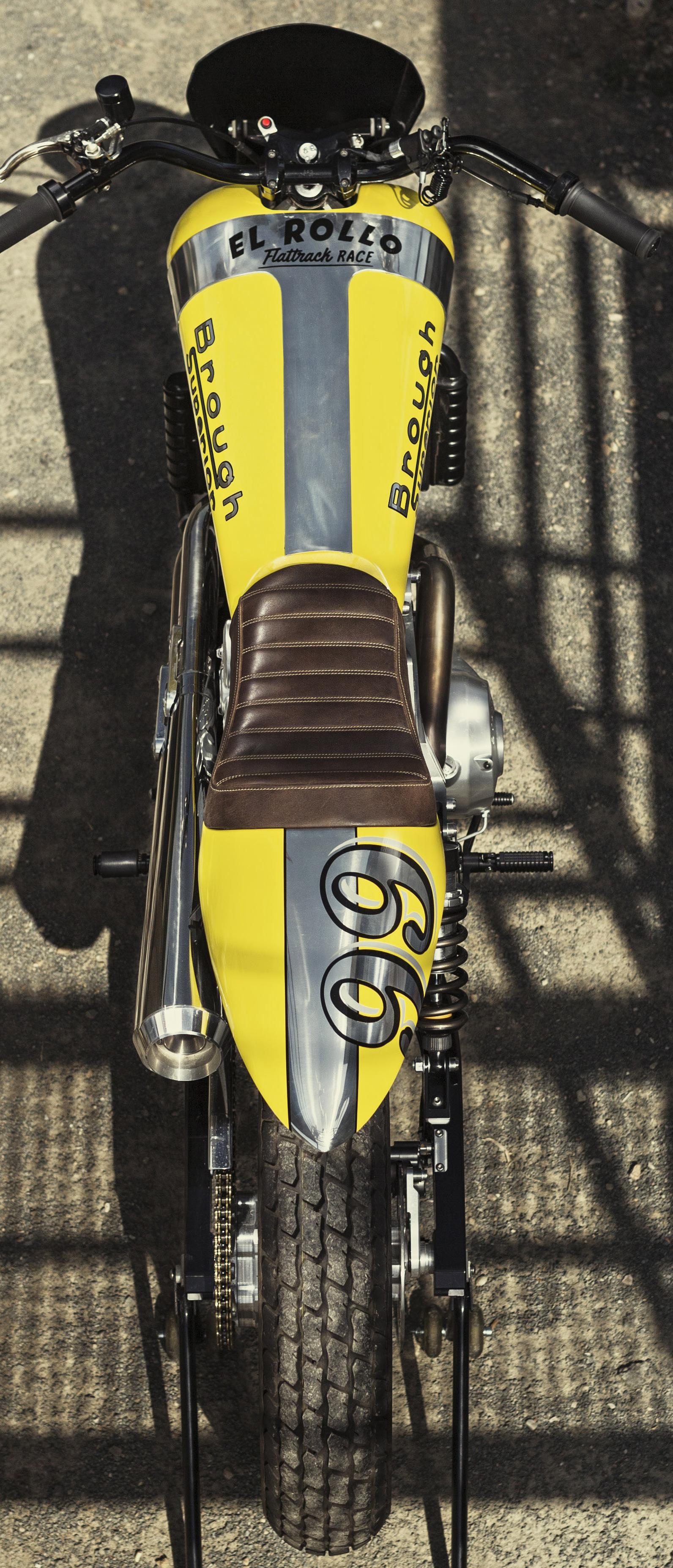
As it stands, Wilfried says, ‘An hour of riding [for the photoshoot] gave me time to get used to it. At the end, I tried to push my limits a little, but without passing those of the bike. I was in second gear and took advantage of the good torque this big engine makes. It pulls very well.’ But he did add that the rear suspension was a little soft.
Brough are vowing to continue this race bike’s development, but given that each year there is only a handful of the kind of gentleman’s races that appeal to both the company and its potential customers – this Brough is £58,000 off the showroom floor, remember – it wouldn’t be a huge surprise if the guts of the bike are repurposed for another, completely different, marketing opportunity.
Frame of titanium, wheels of aluminium, nerves of steel.
58 grand, don’t crash, Wilf


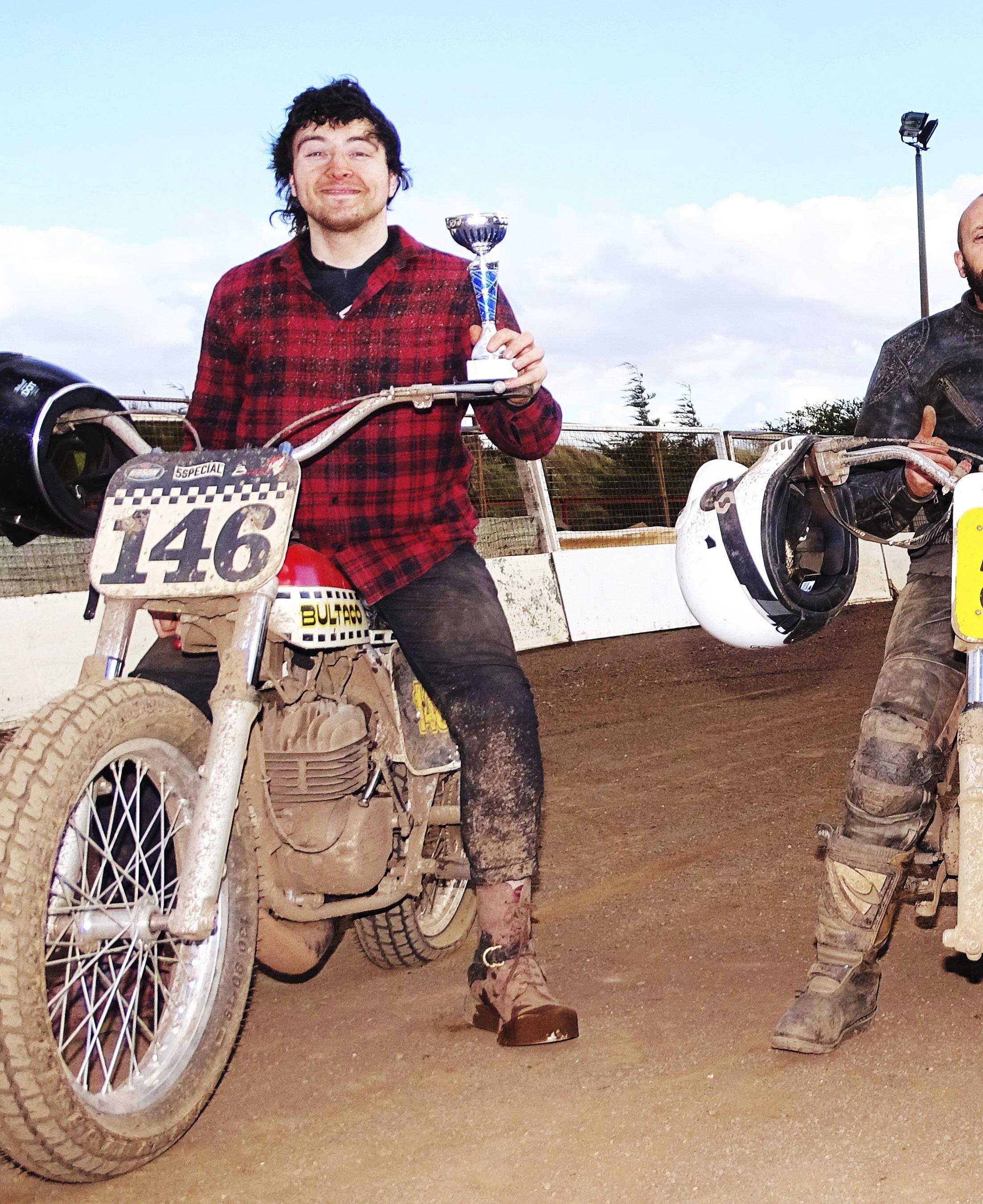
story of how i found my dream machine by danny williams
to scunthorpe from barcelona
89
here is the
>
my story starts here
IT WAS BACK in 2008 that my dad offered to pay for an intensive riding course for my 20th birthday to get me started riding. In the space of a few weeks I went from never riding a motorcycle in my life, to turning up at the test centre on a sunny spring morning, ready to take the practical test to get my road licence, on my Kawasaki KMX125.
I passed, but after that I only went trail riding around Lincolnshire with my old man and his mates, and rode to work a few times when my car broke down. I didn’t use the bike much, and eventually sold it to put the money into a car project. It would be at least eight years before bikes were in my life again.

My friend Nathan Howitt had started beach racing at Mablethorpe, on the English east coast. He sent me some onboard footage and it looked really good fun.
A few months later, I attended one of the last races of the 2018/19 season as a spectator to see what it was all about. I was walking around the pits at about 9am looking at all the bikes. There were so many different kinds, it was interesting to see the different ways they had been prepped for the beach. All of a sudden, one bike was started. Two minutes later all the bikes were running. Two-strokes, four-strokes, one-, two- and four-cylinder bikes, all revving away, each one adding a different noise to this internal combustion orchestra. It was deafening, but a moment I will never forget. I had the biggest smile on my face just looking around and taking it all in.


The race I remember the most was the Unlimited class. Off they went with a huge roar and trails of sand flying tens of metres back. I fixated on rider #51. He was riding a really goodlooking machine, a white Honda twin-shock with gold wheels and he was running rings round the others. His riding was so stylish, he effortlessly glided round the oval and appeared to be in a different league. I later learned that this was Steve Lomas, riding a beautiful Honda XL500. I took a photo of it on the day and couldn’t stop looking at it once I got home. I think this was the moment that I knew I was buying a bike and racing the next season.
 Photos: Braking Point Images, Billy Parker, Ian Rispin, Ferran Mas, Danny Williams
Photos: Braking Point Images, Billy Parker, Ian Rispin, Ferran Mas, Danny Williams
(clockwise from top left) A line-up of NOS (new old stock) Bultaco Astro frames and engines being assembled for the very first time, 40 years after they originally left the factory; Ferran Mas’s Spanish workshop where the limited run of race bikes were assembled. 2019 Husqvarna 701 Svartplien fits in suprisingly well; Astros ready for launch; Ferran Mas, the man with a plan; The stock of unearthed parts when it arrived at Ferran’s workshop; Lectron carbs with clear float bowls to make it easier to work out why your 1970s-spec racing two-stroke decides it wants a break from racing just as your heat race lines up...

i knew almost nothing
I knew almost nothing about bikes at this point, so I submerged myself in motorbikes, reading and looking at as much as I could. I spent hours on eBay looking for old bikes to turn into a beach racer. I did know I liked twin-shock bikes. The more I read, the more I started to find out about flat track racing. I was completely drawn to the old stuff: XR750s; Trackmasters fitted with old Triumph and BSA twins; the Kenny Roberts Yamaha... generally all the old framers. It was somewhere around this time that I saw the bike that made me stop and think THIS IS THE BIKE I WANT!
It had great lines, the paint was really cool and the engine looked like a sculpture. It was just beautifully simple and one of the best-looking bikes I’d ever seen. It was a Bultaco Astro. This was now my dream bike, in the same way that a Jaguar E-Type is my dream car. It felt unlikely I’d ever buy one.

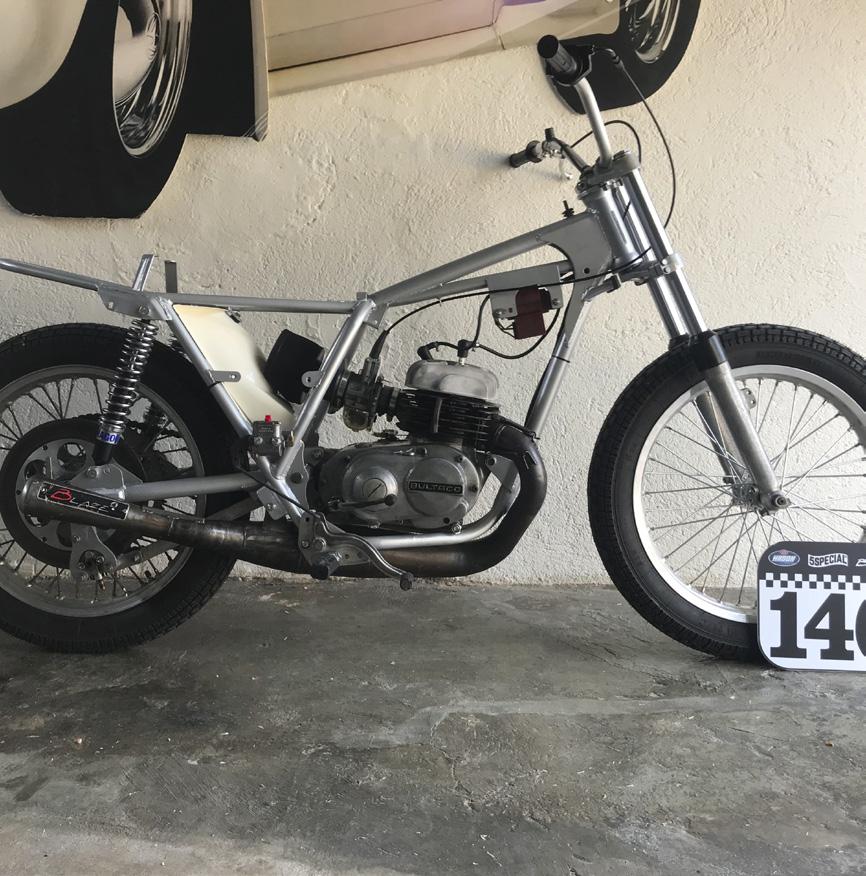
All this flat track stuff led me to find Pete Boast’s Champions Flat Track School. That was the first time I’d been on a bike for years and I was nervous about turning up as a complete novice and making a fool of myself. It took me a little time to get comfortable on the bike, but Pete and his team were so good at making it all very simple and building up my confidence. In no time at all I was pushing my limits and falling off trying to go flat out. I went home with a sore left leg and an addiction to flat tracking.
I booked myself onto the level-two course and continued my search for a bike. These courses were so important for me as a non-biker going into racing. I got to speak to guys who had been doing it for years, learned the techniques that


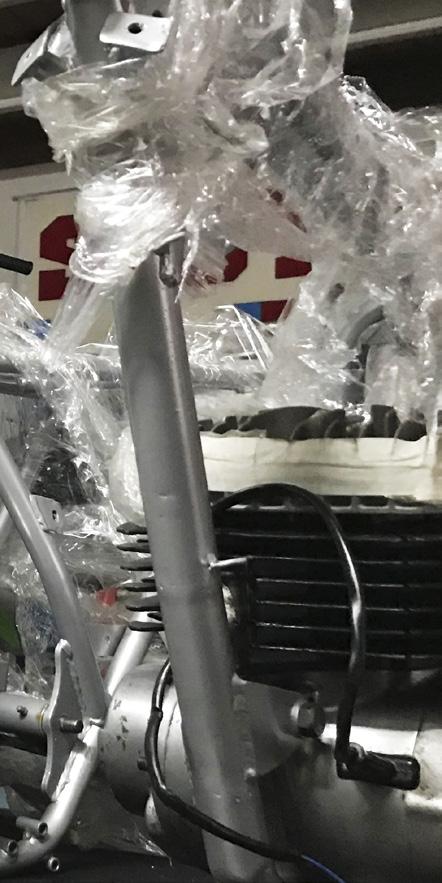
>
would become the foundations for the way I ride now, and it was also where I learned about the DTRA and Scunthorpe flat track races.
So, I’d done two courses, got the bug, but I still didn’t have a bike…

i would never get the chance to own one. and then suddenly, i did
I was scrolling through Instagram one day after work, looking at the stories people had posted that day, when I came across a post from a random account I was following. It was a photo with a caption saying something like, ‘If you are after an Astro, @ferrigas will have five up for sale soon. Message him for details.’
I honestly thought I would never get the chance to buy a bike like this, so without a moment’s hesitation I sent this guy a message. He told me he was in Barcelona and that maybe in a couple of months they’d be ready. A couple of months later I got a message from him: ‘Do you want one?’ I had just been given a project at work that was in Spain and I was due to fly out to Barcelona in two weeks’ time. Now, if this wasn’t fate, or a huge sign that I should buy this Astro, I don’t know what is.
I arranged to visit the man I’d still only contacted on Instagram, Ferran Mas. This would be the first proper flat track bike – and of course the first Astro – I’d ever seen in the flesh.

I got to his home and we walked into a workshop that was bigger than his house. I’m thinking to myself, What a guy! It was full of really cool bikes, helmets, posters and interesting bits of motorcycles laying around everywhere. He took one of the Astros outside, put it in gear and ran down the driveway, bumping it into life. It just sounded cool. Old two-stroke bikes make a different noise to the more modern ones, and it’s so satisfying... the noise, the smell. He didn’t have to say anything else. I was sold.
He told me the story of how a guy in southern Spain had seen an article in a magazine about Ferran having a lot of success racing an Astro, and so got into contact with him to say he had a warehouse full of Bultaco Astro parts. Long story short, he ended up buying absolutely everything off this guy. He got it all back to his workshop, catalogued it and worked out that he could build five Astros as they would have been made back in the ’70s. With the help of his father, he had assembled them in less than a year and was
selling them ‘ready to race’. I got talking to him about my plans, that I wanted to start racing in the DTRA Vintage class in 2020. It turned out I was speaking with Ferran Mas, 2017 DTRA Hooligan champion and Vintage rider. What a small world we live in. Anyway, we made a deal and went our separate ways.
The time came to go and collect the bike. Again, I had work planned in Spain, so instead of flying, I borrowed my friend’s van and headed to Folkstone to catch the 1:30am Chunnel train to Calais. I then drove to San Sebastian in Spain, where I would be working that week. Once work was finished I had an amazing drive over the Pyrenees on a really gorgeous day. Time flew as the scenery was so impressive, and before I knew it I was in Barcelona.
The plan was that each of the guys who’d bought these bikes from all over Europe would meet on the same day to collect them, then we would all go to the track for a practice day before heading home. Unfortunately, a heavy storm caused the whole day to be rained off. I put the Astro in the back of the van and set off on the 22-hour drive back to Lincolnshire, over 1000 miles away.
Just before I left Ferran’s house, I posted a photo of the bike to my Instagram. From this, I got talking to Ben Eddings, a UK guy who races a Bultaco in the DTRA. He invited me to join him at the Rye House track for an open practice session. I am so thankful we became friends so early on, because it has made my journey into flat tracking so much easier.
i raced it
I raced in the Scunthorpe winter series last year and ended up with a third in the overall standings. The races gave me a wonderful introduction to vintage flat track racing over a relatively short period of time. If someone’s bike breaks, we all try to help out and share spares. If someone falls off, we all want to make sure they are OK and back out for the next race. Congratulating, commiserating… It makes the whole experience so enjoyable and gets you counting down the days until the next meet Obviously, racing during a British winter has its challenges with the weather and the usually wet surface. Most of the guys run speedway tyres, but I’m running the Dunlop DT3 tyre, so it’s been good practice to race with not much grip. I got a telling off from Ferran after posting some photos from a really wet race day in January that showed me and my bike absolutely caked in mud. I had my first day at the Greenfield oval in Spring 2020. What a place! The surface is just

(clockwise from top left) Danny in Spain, ready to load up his new bike and head for home, over 1000 miles away. Yes, his driving uniform is the same as his racing one; Ride it, don’t hide it. Danny’s rare Astro was never going to be just an ornament; First time riding on Greenfield Dirt Track and straight into the groove; On the startline...; And racing in the Scunthorpe winter series; Danny’s enthusiasm inspired his dad to buy his own Bultaco race bike, this one an even rarer Champion Astro framer
perfect and it’s my favourite place to ride so far. It was so impressive seeing all the really fast guys blasting round on DTX bikes and the big, powerful framers. It was also the first time I got to experience the sound of a big twin flying past on full chat. I have so much admiration for the way these guys make it look effortless and are super stylish with it. It makes me really keen to improve my technique and lap times with every practice day and race I go to. It’s become a complete obsession.
The prospect of a great year was made even more interesting by the fact that my old man, Vaughan, told me, ‘I’ve decided to get a flat track bike to come racing with you. Keep your eye out for something like yours. Light, two-stroke and old.’ You’ll be lucky, I thought. They don’t come up for sale in the UK very often. Much to my annoyance, literally two days later a Championframed Astro came up for sale less than a couple of hours down the road. Jealous? Me?
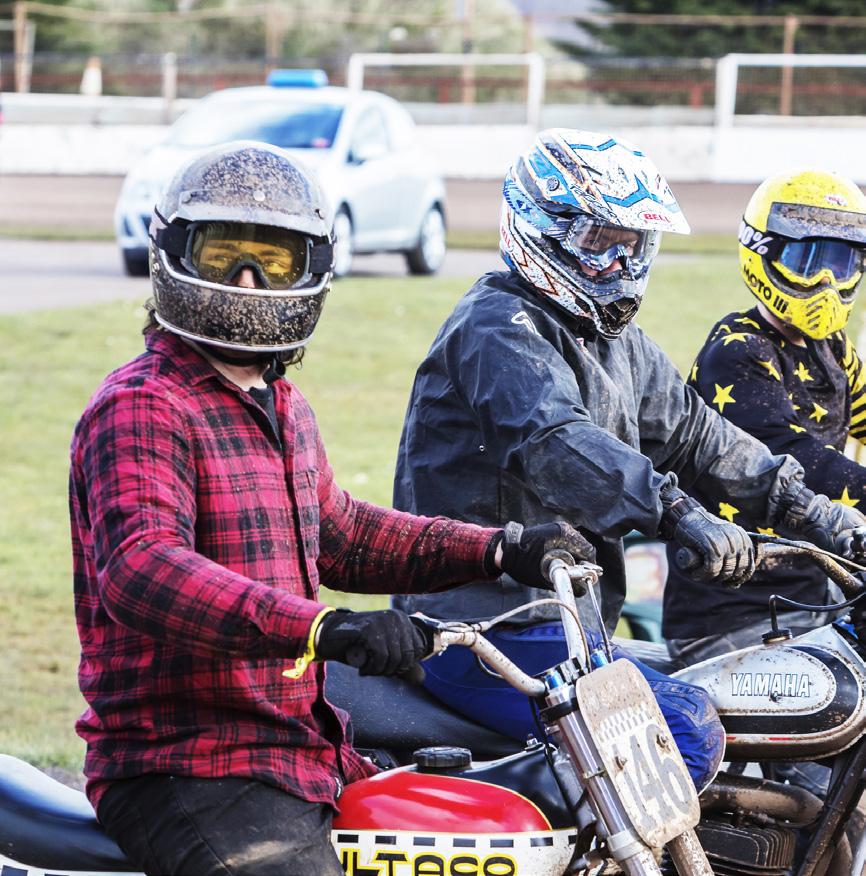




The pressure’s on now. I’m really happy that I’ll be competing against my old man on race day. We are both quite competitive guys, so I know it’s gonna be a lot of fun! Good luck Vaughan! You’re gonna need it!


HAVE FUN!!

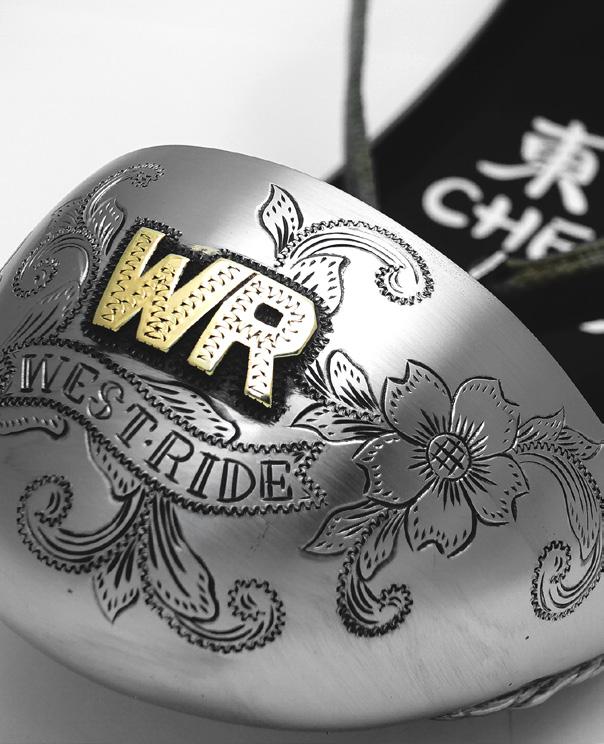

CHEETAH STEEL SHOE






95
スティールシューは速く走るためには必要 なアイテム。 これらはすべてオーダーメイドで作られ ます。 あなたのシューはあなただけのモノ。 だったらあなたの愛するレースバイクと同 じように カッコよくカスタムしてもいいんじゃない? よりフラットトラックが好きになります ! 次号はスティールシューの作り方でも
Words
& photos:
Toshiyuki ‘Cheetah’ Osawa



Cordell


97
Cordell Ona is one badass mofo and does not give one damn. ‘It’s my life. No regrets. I don’t care. All or nothing. Now or never. My way or the highway. No matter what. Not my problem! Screw your plans. Screw your future. Screw your dreams. Screw your good intentions and screw you! LOL!’ Cor is living his life like there’s no tomorrow. And maybe that might become a reality very soon if we just don’t give a damn together. Words & illustration: @lennardschuurmans
A
glimpse into the lives of Lennard Schuurmans’ tattoo flash characters
Project bike

THE LAST TIME I wrote about my Honda 650 sand racer was in Sideburn 36. I’d just won my first Mablethorpe sand race outright, the day’s five races adding to a total of points. It was my first ever first-place trophy (this stuff doesn’t come easy to me). I also reported the crank had seized solid a couple of race meetings later, in the middle of the 2018-19 season. With not enough time or enthusiasm to rebuild it for the end of the winter’s sand race dates, I parked up the bike to prepare for the Dirt Track Riders Association flat track season, leaving the Honda engine in roughly one hundred pieces and the cases practically bare.
Over the coming months, and definitely not in any rush, I bought a Pro-X replacement conrod kit, for £184 from eBay. Next, on recommendation from Anthony at the DTRA, I sent the crank
and new rod kit to PJ Motorcycle Engineers in Wolverhampton. For £66, including return shipping, they rebuilt the crank. It looked fantastic when it was arrived two weeks later.
The year flew by and the start of the Mablethorpe sand race season neared, but the engine hadn’t moved. I’m sure I could have paid Carl at CFM to rebuild it, but I wanted to do it myself. I say I wanted to, I can’t have been that committed, because the season started in October and the engine still hadn’t moved, the rebuilt crank remained in a cocoon of bubble wrap. In part I blamed being busy with work, but part of it was being daunted by the rebuild, and another facet was mislaying the list I’d made when I stripped the engine in January noting the parts I had to replace. Eventually, I found the oily scrap of paper and ordered the consumables from Honda specialist David Silver Spares. I got
everything I needed, including seals, O-rings, bearings and a new gear selector shaft and lever.
Finally, I got my act together. Working on a bench in the corner of CFM’s workshop, allowing me, if I was unsure, to check with Carl, who really does know everything about bolting engines back together. It all went smoothly, until I tried to fit the clutch basket and somehow broke one of the fingers. A local engineer welded it back together the same day. A seamless fix.
It’s not a light engine, compared to a 450 motocrosser, but it is an easy fit in the modified SLR650 frame. The featherweight stainless Co-Built two-into-one exhaust and big Mikuni both slotted right on. The lithium battery was fully charged. I laid the bike on its side to flood the carb (for some reason it likes this), gave it five or six kicks and it started. The engine was so quiet.
sounded like

Almost
a year in pieces, before a return to the Mablethorpe podium
It
23 17 15 5 15 23 27 30 15 15 40 30 10 35 23 17 15 10 Inexplicable procrastination 15% Podium return 15% Change of heart 30% Birth of new project 40%
Slash
Cut Co-Built pipe is the business. Mablethorpe don’t have sound regs Words: Gary Inman Photos: Braking Point Images (action), Sideburn
No Brakes
Unlike
flat
Max Attack
I’ve never felt as aggressive as I did in this race. I’d spent the day before riding at Greenfield Dirt Track

a Honda again. Now it has a rebuilt crank, nearly new Wiseco piston and Kibblewhite valves and springs and a three-races-old Newbold-tuned head. After nearly 12 months, it had taken me, an inexperienced engine builder, less than two days to assemble the engine from bare cases and have the bike ready to race again. Who knows why I’d put it off so long, but I hadn’t just been sat on my arse watching TV.
A year to the weekend after the bike broke, I was back at the beach. The engine felt great, strong, fast. I was loving racing again, battling in the Unlimited class. Then, like a candle being blown out, I lost my enthusiasm. I was driving home,
third place trophy on the seat next to me, and just decided that was it. As much as I love racing, and I really do, everything else was being put on hold. After a few seasons of racing regularly through the summer and then a different series in the winter I’m going to concentrate on dirt track and just keeping the Wood Rotax race ready. Due to the Covid-19 situation wiping out the remaining rounds, my final race was also the last race of Mablethorpe’s 50th year of racing.
Within a couple of days I decided I was going to convert the Honda to short track spec and sell it. Read all about what that involves in the next issue.
CONTACTS
Read the previous sand racer project bike

pjme.co.uk davidsilverspares.co.uk cfmofsleaford.co.uk co-built.net
instalments in Sideburn 30, 31, 32 and 36.
my
tracker, this sand racer has no coward pedal
99
Racewear
Trusted: Brandon Robinson is a multiple Grand
National winner and a threat at just about every track the AFT Super Twins series visits. He has also come back to win after injuries that would finish most careers. This is his 2020 race kit and essentials
1 Alpinestars
Tech-Air leathers

The crew at Alpinestars provides me with the most badass airbag suit. It adds that extra confidence knowing I’m protected as much as possible.

2 Alpinestars
Supertech R boots
I love these boots. I’ve worn them for the majority of my professional career. Great protection and the comfort needed to feel those foot controls.
3 West Coast Hot Shoes steel shoe
Wade from WCHS has been making my hot shoes for a long time. Sturdy and dependable. Second to none.
4 Girlfriend’s message
I have this plate screwed onto the side of my hot shoe, from my girlfriend Ashley, that reads, ‘Ride safe. I need you here, with me.’ It’s one of those things that just hits the heart and I love that she supports what I do.
5 Arai Corsair X helmet
Safety first, kids! Arai have backed me since I turned pro all the way back in 2007. I run the Nakasuga replica because it flows so well with my kit. You wouldn’t catch me wearing another brand of helmet. EVER.
6 Alpinestars Rage
Drystar gloves
CE certified, carbon knuckles, leather gloves. These are tougher than I am.
7 Alpinestars Ride Tech Summer base layer
I wear a base layer, top and bottoms, to help me stay cooler and to be able to
slide in and out of my leathers easier on those hot, sweaty days.
8 Alpinestars
Komodo gear bag
This bag is essential. It’s big enough to carry my entire kit: leathers, boots, helmets, gloves... the whole shebang.
9 Alpinestars rucksack
Always rocking the schoolkid look in the paddock with my book bag on. Gotta carry the essentials somehow.
10 Scuba Steve bracelet
My buddy’s dad passed away last year and they made these bracelets in his memory. It broke after wearing all of last year, but I tied it on my book bag so he is always with me. Scuba did a lot for me at a time when I didn’t know how I was going to make it, race to race, in my early pro years.
11 Alpinestars Race Socks
Exactly how it sounds. Go fast socks!
12 Ultra-Shield tearaways
Gotta have those fresh, thin tear-offs on race day for clear vision.
13 Intake Breathing
I’ve been wearing the Intake Breathing kit over the last year, and I’ve found it helps to really open up my nostril passages to help me breathe better.
14 AFT credential
Sorta need this to get into the races. Wear it out to dinner to let everyone know you’re a pro. LOL.
15 Mouth guard
I don’t think there’s a racer out there who hasn’t smacked their head good at
Name: Brandon Robinson
Age: 29
Job: AFT Super Twins racer
Hometown: Ormond Beach, FL Bikes
Work bike: Indian FTR750
Personal bikes:
2011 Honda CRF450
2012 Honda CRF450
2017 Honda CRF450
J&M Honda 450 framer
J&M Rotax 600 framer
least once, myself included. I started wearing one in 2015, because it’s [thought] that it can help reduce the risk of a concussion, which helps ease my mind because I know I’m doing everything possible to stay as safe as I can.
16 Team shirt
Gotta look professional on race day and represent those sponsors!
17 Roof System hat
Another way to rep those who make it possible for me to do what I love!
18 Pretzels
My go-to snack pretty much all the time. There’s no secret behind it, I can sit there and just eat an entire bag.
19 Go Pivot water bottle
Go Pivot is a supporter of my cycling programme and, well, I just like water bottles. Usually, I have a bottle filled with Gatorade, Drip Drop, Pedialyte… something of that nature.
20 Starbucks coffee
Starbs is my go-to coffee on race day, a caramel macchiato to be precise. Sometimes I have to suck it up and have hotel coffee when there is no Starbs to be found.
Photos: Brandon Robinson, American Flat Track

101 13 14 15 16 18 19 20 17 11 9 8 7 6 5 4 3 2 12 1 10

85% Club Box Set





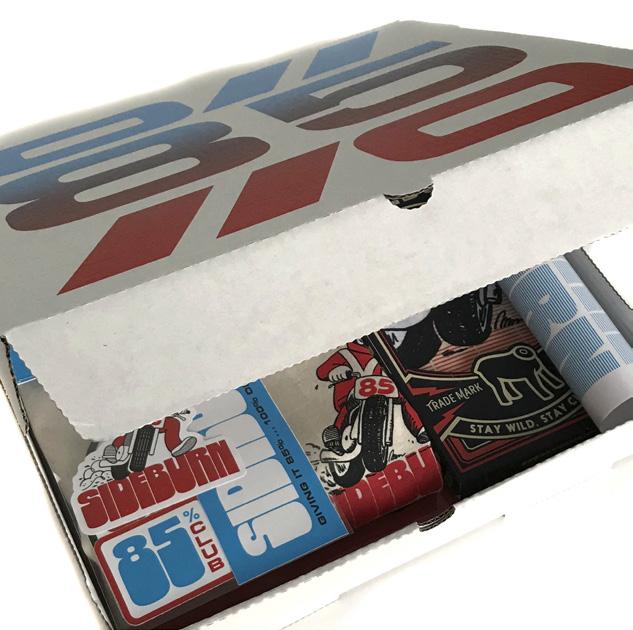
Limited to a run of 85, each with a unique number board. Includes: exclusive T-shirt; stickers; Holy Freedom neck tube and posters in a screen-printed box Order limited-edition T-shirts, sweatshirts, skate decks, hats, magazines, art prints and more Shipped worldwide Visit Sideburn.bigcartel.com
DEEP IN THE THE VAULTS



The Shell Suit Era
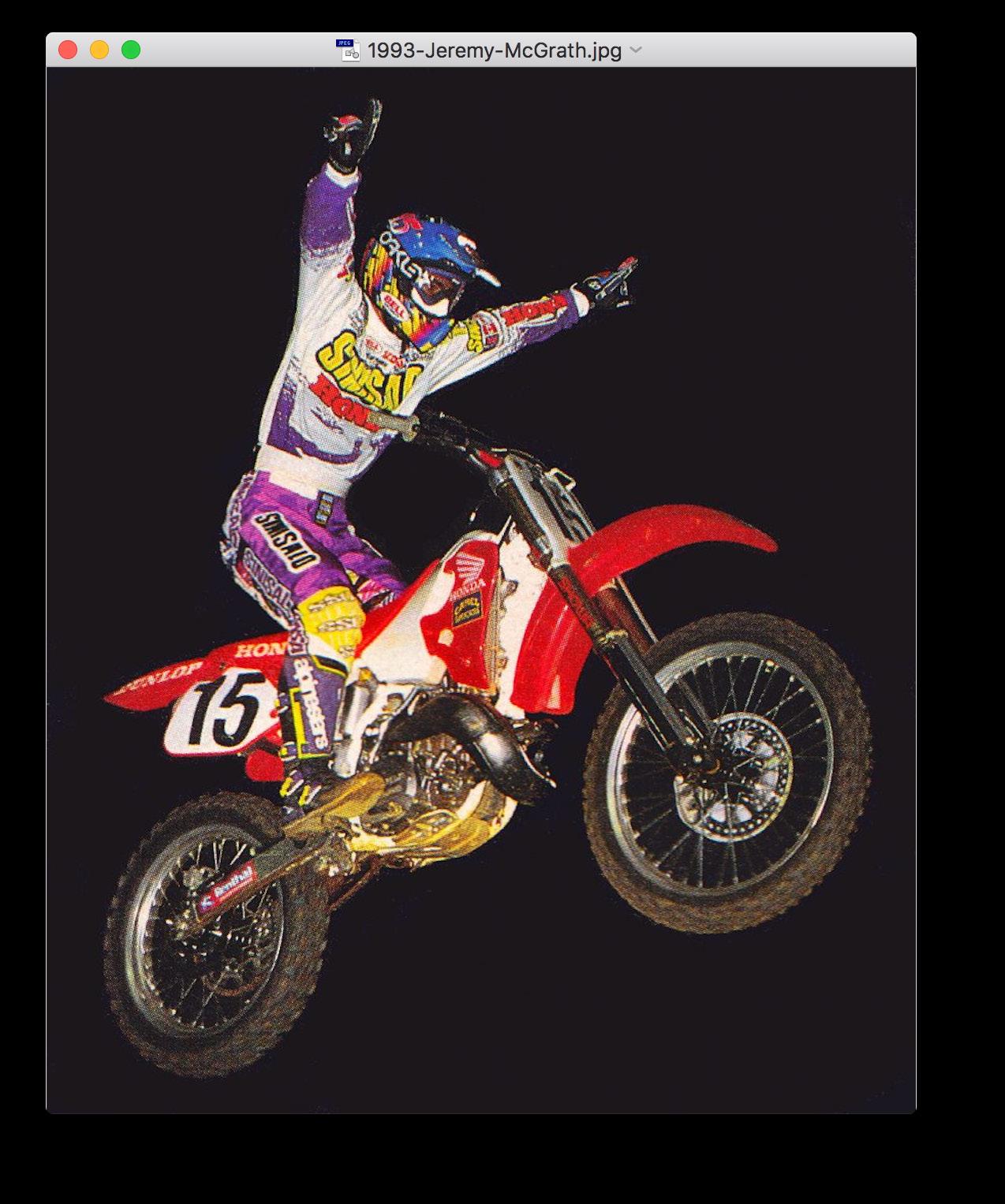
I think this is the first time Andre Agassi has appeared in Sideburn. And this was the edition of my column (where I share found images from my hard drive) that I really wanted to be on brand and talk some moto stuff. OK so Ricky Graham (1993 vintage) is bottom right and Agassi is top left. The thing that connects these legends: the Suzuki Samurai, the GSX-R750WN, Mike Larocco, even an F1 car, is 1992/93. You see, this was a very peculiar period of design. I think the writers of Performance Bikes magazine at the time might have called it the Shell Suit Bike Era, where everything seemed to have a magenta, mauve, or indigo hue with a dry brush-stroke graphic element. Hot pink in particular was hot, in tandem with an

electric blue like Graham’s 1993 leathers. This wasn’t a US fad; Fabrizio Pirovano ran the pink and blue YZF in World SBK, Pacific had a very interesting entrant in F1 and three of the biggest manufacturers in the world had shell suit colour options. Seeing heavily-styled MX gear in the ’90s came as no suprise, but when mass-produced superbikes look like Agassi’s trainers you know the fashion is real.
And as quickly as it came, the shell suit era ended. The ’94 GSX-R was wild by today’s standards graphically, but more subdued. And Scott Parker won the 1994 AMA title with a more traditional look. It was fun while it lasted.

Shell Suit (chiefly Britain)

A cotton-lined lightweight tracksuit consisting of a zip-front jacket and matching elasticated trousers, each having an outer nylon shell, often bearing panels and flashes of different colours. Popular in the late 1980s and early 1990s both as sportswear and general leisurewear.
 Delving into the the deepest recesses of artist Death Spray Custom’s
Delving into the the deepest recesses of artist Death Spray Custom’s
inspiration
folder and pulling out some gems. This issue, a style bubble
Splatter, dry brush and marker-pen derived graphic elements, coupled with nascent graphic software programs and an exciting colour palette, meant all roads, for a year at least, led to one glorious dead end.



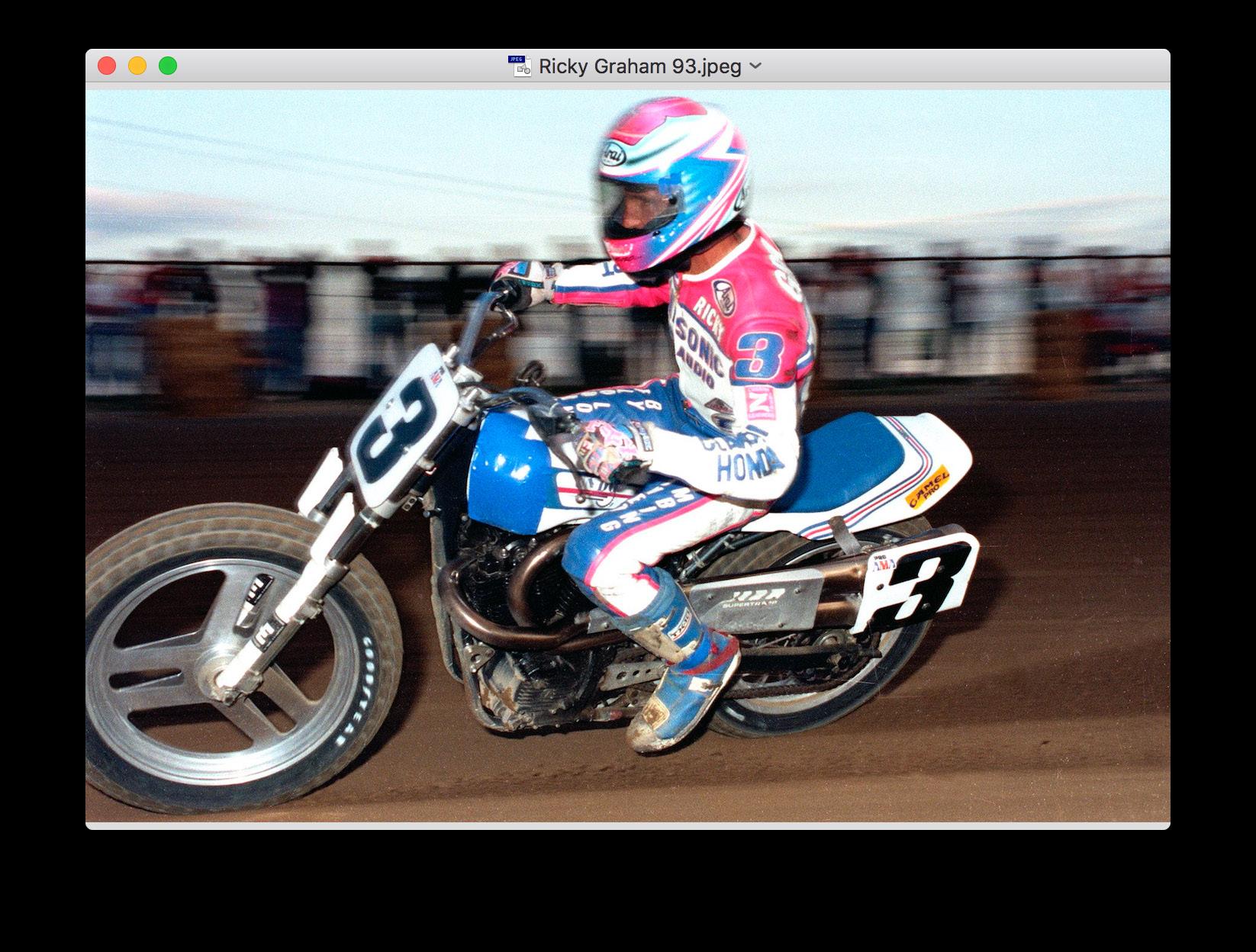






SB: Dave Hoenig of Flat Trak Fotos sent us a shot from Castle Rock. It was 22 September 1990 and you’re holding a number 1 plate. What is that race and what did you just win?
CC: I had just wrapped up winning one (of seven) of my 600cc National Dirt Track Championships.
SB: What bike did you race that night?
CC: 600cc Wood-Rotax in Harley-Davidson colours. That bike is in my basement.
SB: You are famous for your wins at Peoria TT, but how was Castle Rock as a TT track for you?
CC: Castle Rock was a great track for me. I won about as many races there as Peoria. They just weren’t all GNC races.
SB: Did the local guys have the track sewn up at Castle Rock more than they did at Peoria?
CC: It was a local track that held a few nationals over the years. Peoria is a national track that only held two races a year, so locals did not have an advantage.
SB: The trophy queen is not shy. What is your recollection of trophy girls back then?
CC: It would be fair to say that everybody was much less cautious and politically correct in the ’80s and ’90s. Since I don’t race at the level today that I did in 1990, it would be unfair for me to compare then and now. As an outsider now, it does not appear to be any safer today, despite valiant efforts. Racing is dangerous in any era. I enjoyed 1990 as a racer, and I enjoy watching today’s racers, too. There are fewer professional racers today than there
were in 1990, so it is fair to say that there was more depth of field in 1990. However, today’s top riders would be top riders in any era. What we had in 1990 was what we had. One advantage of essentially single-brand racing in 1990 is there was much less politics. Today, with multiple brands, the political landscape changes with the wind. Today’s racer has to have a sense for the political climate much more than previous eras.
SB: Did you initiate the kiss or her?
CC: I have no recollection.
SB: What do these photos remind you of?
My early 20s.
CC:
>> From: Chris Carr To: Sideburnmag@gmail.com Date: 29 April 2020 Subject: Sideburn Trophy Queen 15 30 15 40 30 35 23 17 15 10 Castle Rock Raceway 1990 Mass of hair 23% Low bodyfat 10% Help me, I’m drowning 35% Wouldn’t happen today 17% Possible tongues 15%

107
Photo: Flat Trak Fotos











































 Words: Jeffrey Carver
Photos: Ed Subias (static), Flat Trak Fotos (action)
Words: Jeffrey Carver
Photos: Ed Subias (static), Flat Trak Fotos (action)


















 Words: Bill McDonnell Photos: McDonnell Family Archive
Words: Bill McDonnell Photos: McDonnell Family Archive































 Words: Gary Inman
Words: Gary Inman





















































































 Photos: Braking Point Images, Billy Parker, Ian Rispin, Ferran Mas, Danny Williams
Photos: Braking Point Images, Billy Parker, Ian Rispin, Ferran Mas, Danny Williams



















































 Delving into the the deepest recesses of artist Death Spray Custom’s
Delving into the the deepest recesses of artist Death Spray Custom’s











